Each year, Support Driven and Help Scout team up to survey customer support professionals about what they earn relative to their experience, company size, location, gender, and other factors. We then analyze that survey data and publish this study.
Over the years, the customer support salary study has become an indispensable data point in a broader and evolving discussion about the value of customer service work — a critical discussion to have when companies are increasingly competing on customer experience and support professionals have greater choices among employers who value their skills and compensate accordingly.
We continue to conduct and publish this study so that managers, employees, and job seekers can have more informed conversations about compensation and professional development.
2018 support salary study
It’s that time again! Support Driven and Help Scout have teamed up to conduct an anonymous survey among customer support professionals around the world, asking what they earn in regard to their gender, race, local cost of living, seniority, and other factors. We then take a close look at that data to bring you this report.
This report isn’t intended to serve as a definitive guide for how much support professionals everywhere should be paid — it’s simply one data point in a broader and evolving discussion about compensation and industry standards and should only be used for context and in conjunction with other sources.
Changes from last year's survey
We love hearing your stories about how you’ve used the study in conversations about compensation! Based on feedback about what kind of information is useful to bring to those conversations, we changed some of the questions we asked in this year’s survey:
Which option best describes your role at your company?
How long have you been in your current role?
Do you work full-time or part-time in your position?
Do you work remotely (i.e not just an occasional work-from-home day)?
How many years of experience do you have working in customer support?
What's your annual salary (in U.S. dollars)?
If you had the same role in 2017, what was your salary then (in U.S. dollars)?
Did you ask for a raise in 2017-2018?
As of 2017, have you changed companies, changed roles within your company, or been promoted within your company?
What gender do you identify as?
What ethnicity do you identify as?
What's the cost of living where you live?
Which region is your company based in?
What is the approximate total number of employees at your company?
What is your business model?
How complex is your product(s)?
What is the size of your customer support team?
Do you receive other forms of compensation (medical benefits, bonuses, equity, work from home policy, professional development, parental leave, 401K or other retirement plan options)?
What skills do you want to learn or develop for yourself?
If you are a manager, what would you want your direct report(s) to learn or develop as a skill?
Adapting the survey each year means we can’t provide a year-over-year comparison in some areas, but it also reflects which questions are currently top of mind for members of the community.
Median salary vs. average salary
This year, instead of reporting average salaries, we’ll be reporting median salaries.
Consider three salaries: $5,000, $50,000, and $60,000. The average is $38.3k, but it's weighed down by the low $5,000 figure. The median — the middle number — is a better representation of what a typical person earns because it’s not influenced by outliers. According to Dan Levin:
The median salary is often much closer than the arithmetic mean to what common intuition would give for the typical salary. Strangely, people, political parties, newspapers, even statisticians continue to calculate the arithmetic mean and present it as a “typical” salary answer, when median salary would be much closer to what people want to know.
Now, onto the good stuff.
What support pros earn
The number of participants has grown significantly year over year:
| 2015 | 2016 | 2017 | 2018 |
|---|---|---|---|
60 | 203 | 551 | 706 |
While a sample size of 706 is relatively small and the results aren’t wholly representative of what customer service professionals earn around the world, the survey helps shine a light on this growing field and enables business owners, managers, employees and job seekers to hold more informed conversations about compensation.
The median customer support salary for 2018 is $50,000. All monetary amounts are USD.
We should emphasize that these are worldwide medians — not just North America and Europe where salaries tend to be higher.
The majority (96%) of survey participants work full time (30+ hours/week). For the rest of the analysis, we’ll focus on full-time employees who indicated they earn at least $5,000 per year. (We made the call to disregard a few entries indicating annual salaries under $5,000 for full time employees — these numbers are likely due to self-reporting errors — e.g., respondents could have misread the line about annual salary vs. monthly).
Gender and ethnicity
706 participants:
408 Women
288 Men
7 non-binary or third gender
3 preferred not to answer
As in years past, the median salary for women ($50,000) is slightly lower than it is for men ($52,000)* — not ideal, but a smaller wage gap compared to other industries in general.
Women make about 95% of what men earn in support in 2018, similar to what we saw in 2017.
Also similar to last year’s report, women earn:
Slightly more than men at entry level.
About the same as men at 5-9 years of experience.
Less than men with at 10+ years of experience.
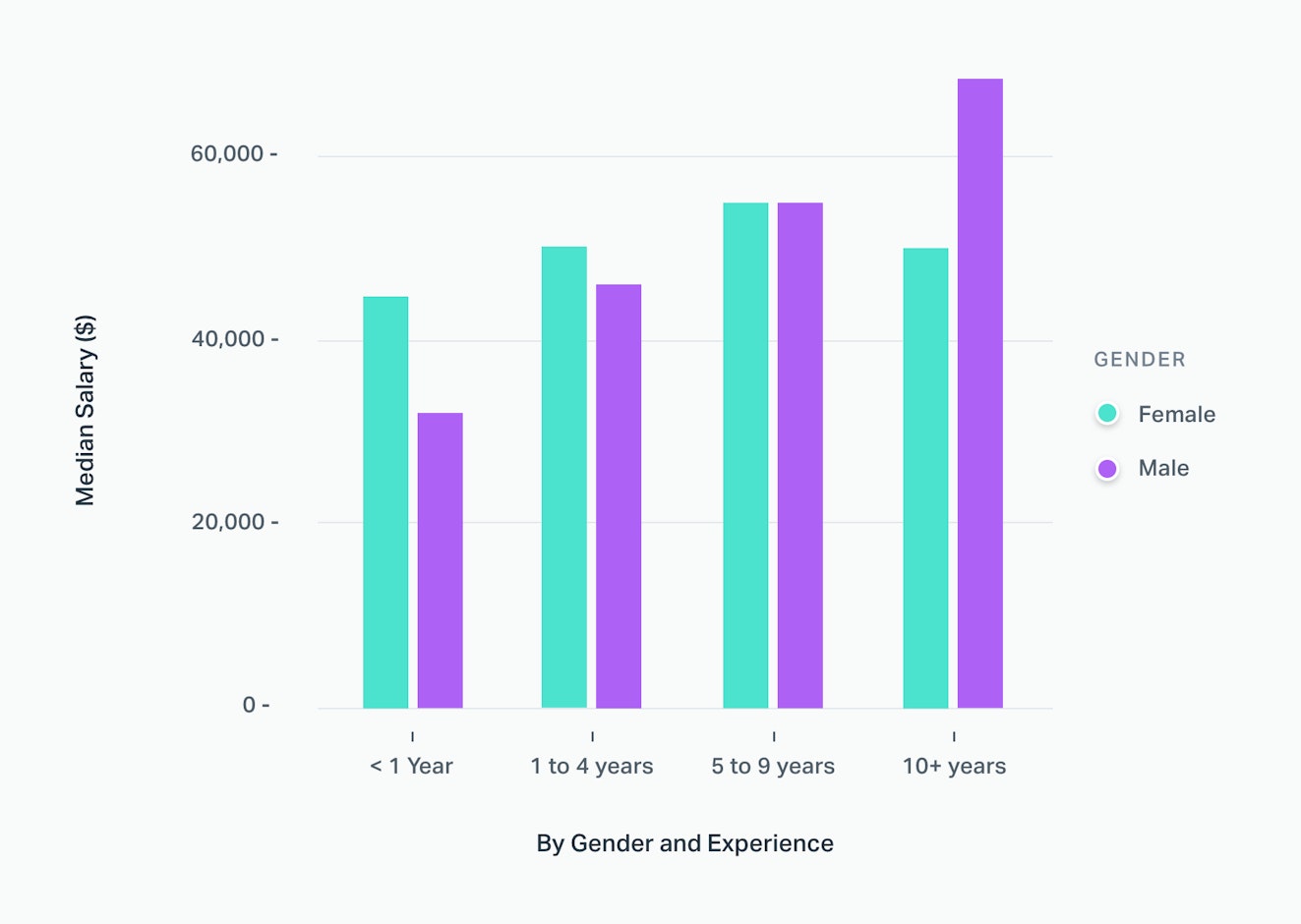
Non-binary, other genders, and those who preferred not to answer are not depicted in charts due to small sample size.
This year, for the first time, the survey included a question about ethnic identity. The breakdown:
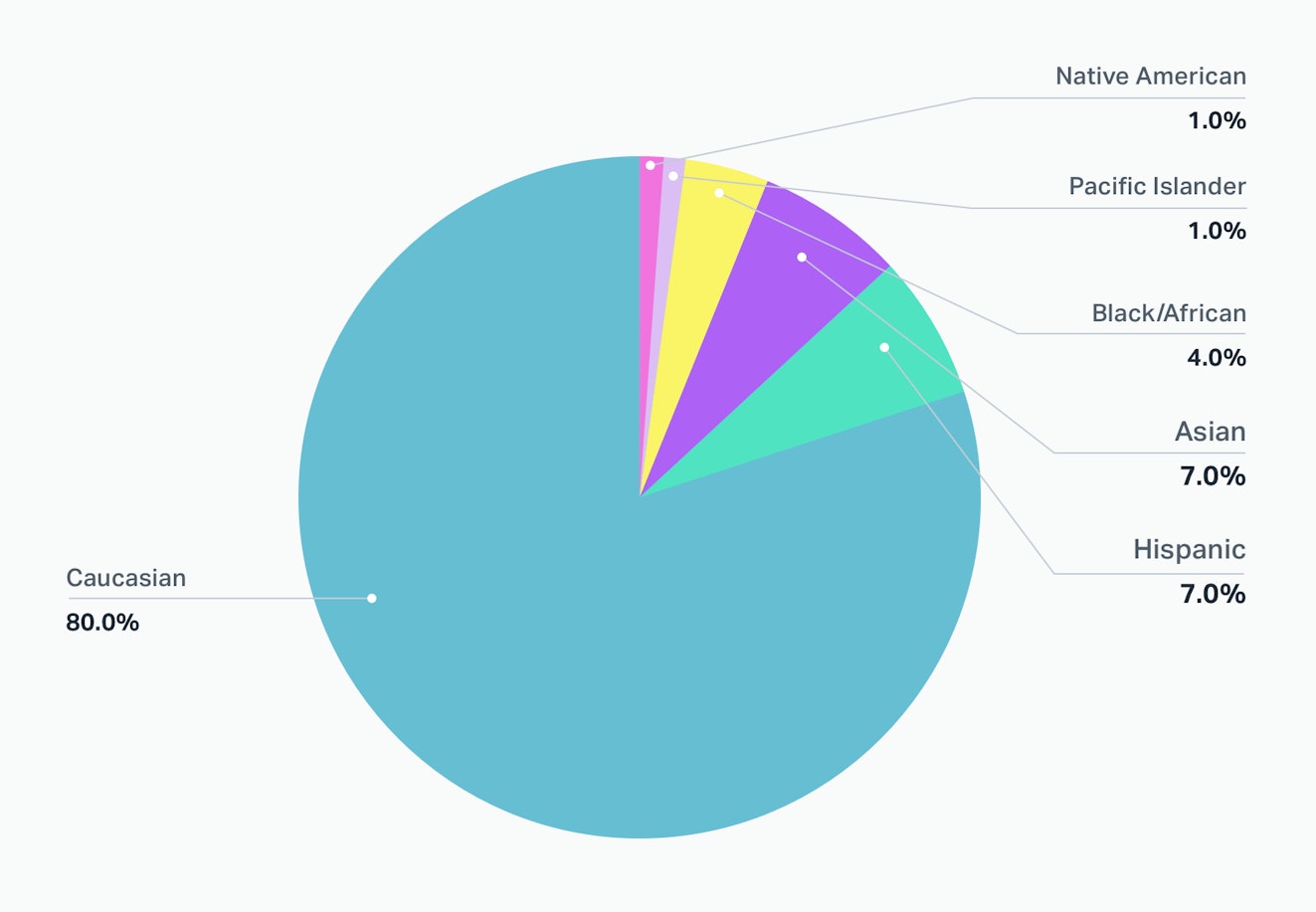
Because most of the survey participants identified as Caucasian, we don’t have enough data about other ethnicities to draw meaningful conclusions about salary differences. We also wanted to avoid oversimplification and false equivalences (e.g., comparing Caucasians’ salaries against all people of color, or reporting that people of a certain ethnicity are paid less when that could be due to other factors like working in lower cost-of-living areas).
Roles, tenure, and experience
Not surprisingly, managers make more money than people who perform only frontline support. Those performing frontline support make $43,581 compared to $55,000 for those who do frontline support and management, and $70,000 for managers and other leaders who don’t do any frontline support.

Women make up:
63% of those who do frontline support
54% of those who manage and do some frontline support
65% of managers
54% of directors and other leaders
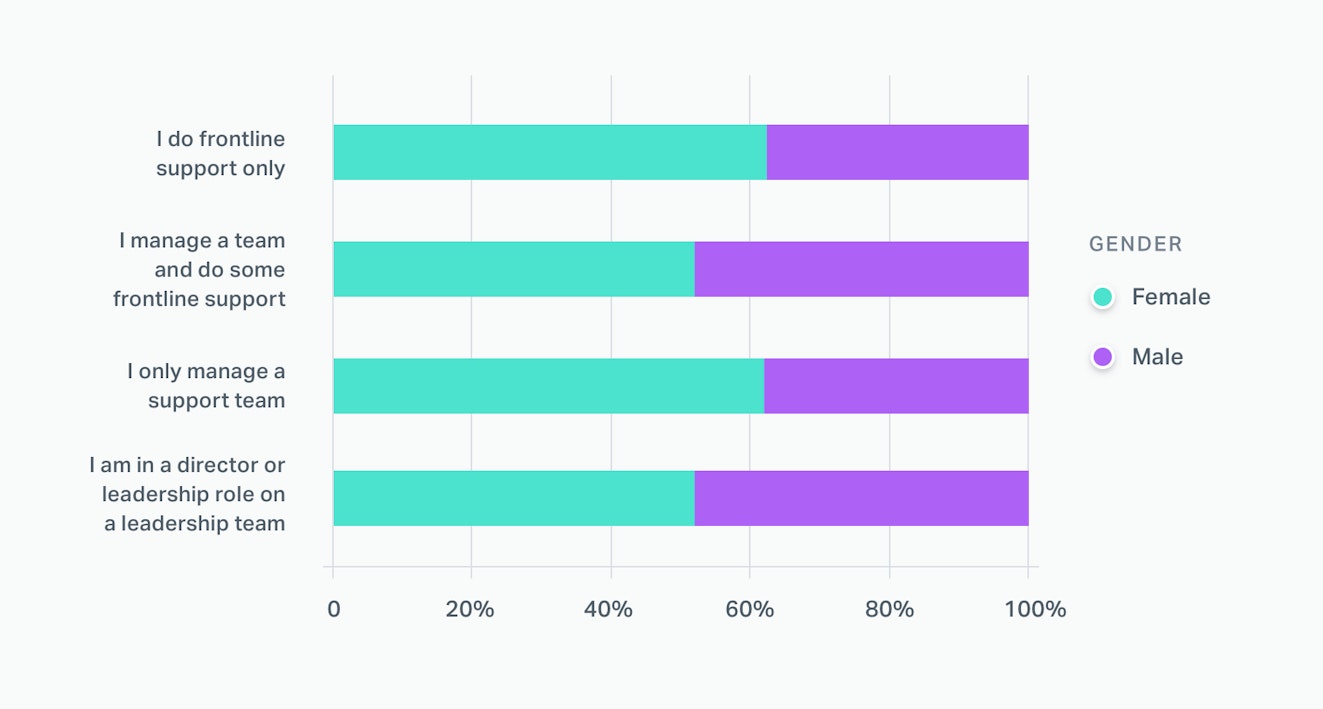
Women tend to earn about the same as men based on role (and for those only managing people, slightly higher):

There are two ways we can look at how experience impacts salary. The first is by how long someone has been in their current role (their tenure); the second is by how many total years of experience they have worked in customer support.
When we look at the numbers by how long someone has been in their current role, we don’t see much of a change: People tend to make $50,000-$55,000 regardless of how long they’ve been in the role.
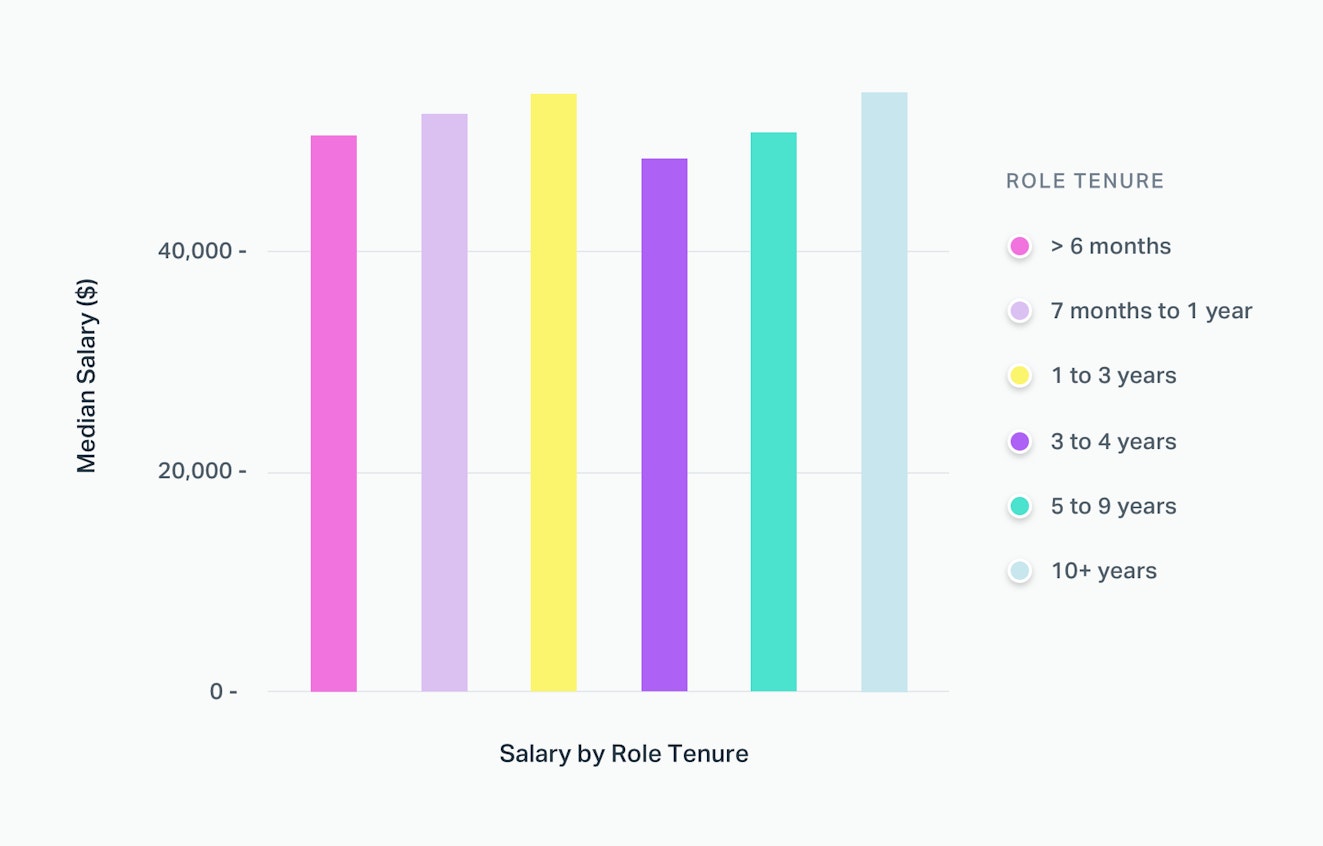
When we look at salaries by years of total years of experience in support, we do see salaries tend to rise as people gain more experience. People just beginning their career in support can expect to make around $37,000 per year, with that number rising to $50,000-$55,000 after several years of experience. That number doesn’t grow much with more years of experience in the same role: Even support professionals with 10+ years of experience in the same role still typically make $50,000-$55,000.
Taken together, these numbers imply that loyalty to a specific company does not impact salary much. It may be that switching companies tends to lead to higher salaries.
In 2017, 38% of survey participants asked for a raise. About 25% of respondents were promoted. About half of all respondents didn’t receive a raise or change roles/companies.
We mentioned earlier that the salaries of men and women tend to diverge with experience. The reason for the difference at 10+ years is driven by a couple factors:
A higher percentage of women in frontline-only roles coupled with a lower salary for those women ($38,500 for women vs. $64,500 for men)
A similar number of men and women in director roles with 10+ years of experience, but those women had a median salary of $65,000 versus $100,000 for men.
Together, these result in the higher median salary for men with 10+ years’ experience ($69,000), compared to women with 10+ years’ experience ($50,000).
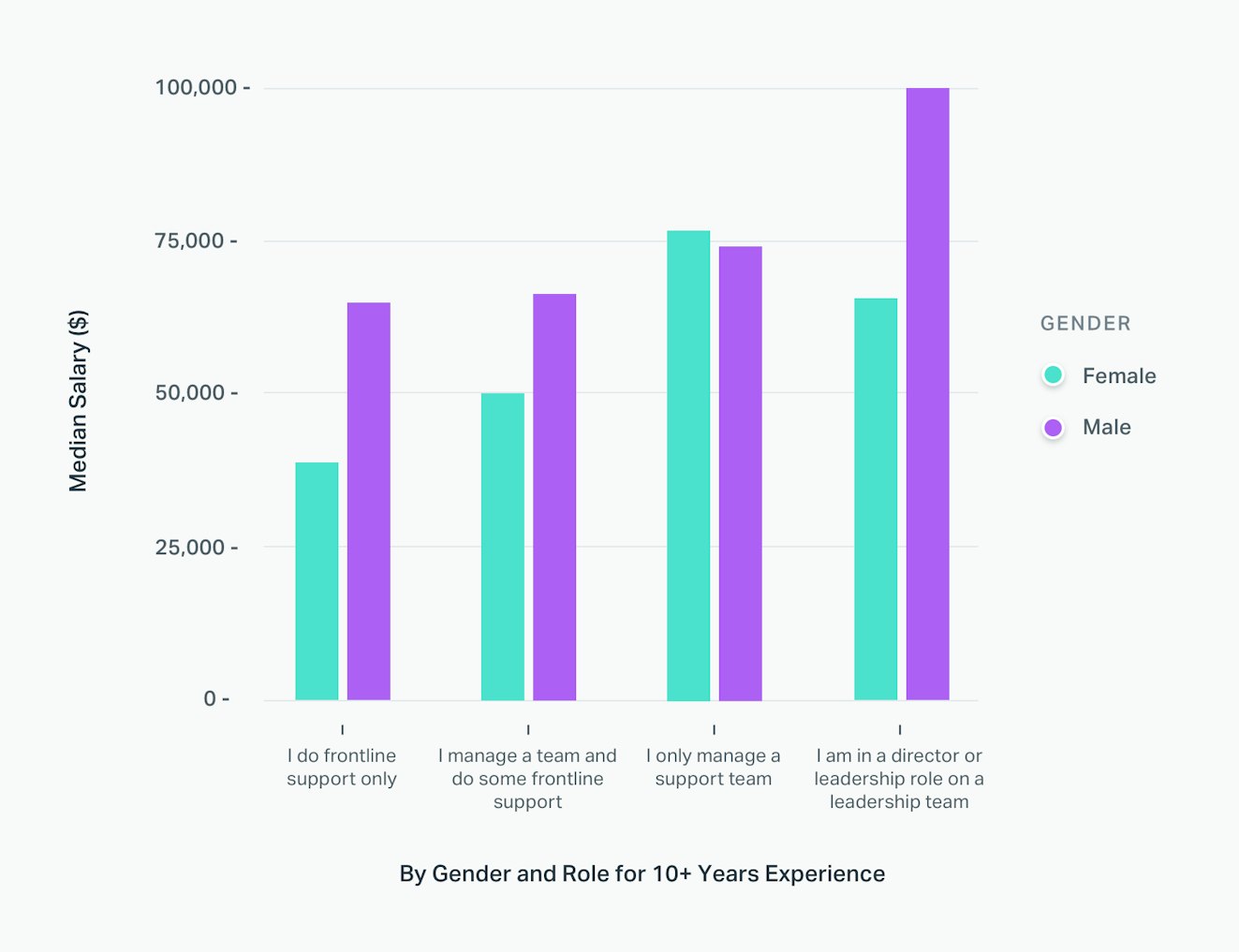
Put another way, men and women in director roles tend to make about the same. However, men with 10+ years of experience make more than women with 10+ years of experience who are in director roles.
Customer support salaries by company region
| Company Region | Number of Participants | Percentage* | Median Salary |
|---|---|---|---|
North America | 495 | 74.8% | $55,000 |
Europe | 111 | 16.8% | $39,000 |
Australia / Oceania | 17 | 2.57% | $49,000 |
Asia | 16 | 2.42% | $14,700 |
South America | 5 | 1.21% | $27,000 |
Middle East | 5 | 0.76% | $55,000 |
Africa | 1 | 0.15% | $15,000 |
No Answer | 9 | 1.36% | $53,000 |
Regions other than North America (with its larger sample size) are only included for reference and should not be considered representative of median salaries in those regions.
North American support professionals typically earn more ($55,000) than Europeans ($39,000).
Salaries tend to rise with cost of living: $14,805 for low cost of living areas like Manila, Philippines, compared to $42,500 for medium cost-of-living areas like San Antonio, Texas, compared to $60,000 for high cost-of-living areas like London.
| Cost of Living | Number of Participants | Percentage | Median Salary |
|---|---|---|---|
$ (e.g. Manila, Delhi, Hanoi) | 28 | 4.23% | $14,805 |
$$ (e.g. Tallinn, San Antonio, Santiago) | 166 | 25.1% | $42,500 |
$$$ (e.g. Nashville, Birmingham (US), Vienna, Austin, Las Vegas, Tel Aviv) | 237 | 35.8% | $50,000 |
$$$$ (e.g. San Francisco, Hong Kong, Sydney, London, Paris, New York) | 213 | 32.2% | $60,000 |
This is where working remotely (more on that in the next chapter) carries the biggest advantage: Living in low- to mid-range cost-of-living areas while working for companies based in high-cost, high-salary areas will maximize your spending power.
Companies with larger support teams tend to pay more: Teams of one-five people earn a median of $47,750 compared to the $55,000 people on teams of five or more earn, and $64,328 that people on teams of 101-500 people earn.
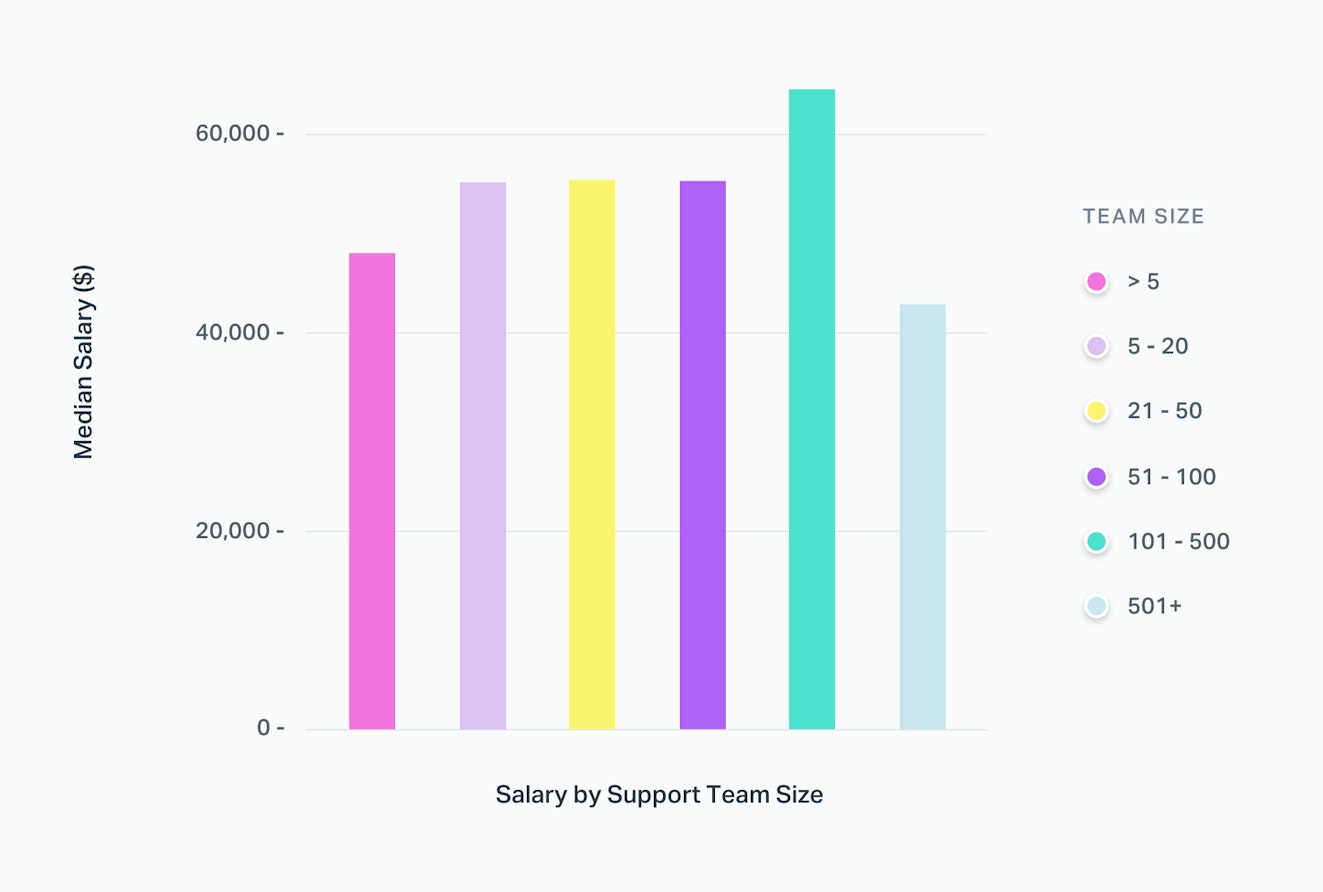
Interestingly, salaries at companies with more than 500 support professionals are the lowest, at $42,562. Only 10 responses came in from those companies, so it might not be fully representative of actual salaries, but that median may also be brought down by the lower salaries paid in call center organizations that employ large numbers of customer service representatives. (Another potential factor is that respondents could have misinterpreted the question as company size rather than support team size.)
About 4 in 10 participants work at a SaaS (Software as a Service) company. Support professionals working in SaaS typically earn $5,000 more per year ($55,000) than those working outside of SaaS ($50,000). It’s true that the software industry often pays higher salaries in general, although the difference may also be due to a growing understanding among SaaS companies that high-quality customer support is a competitive differentiator when it comes to customer experience.
Remote work and other benefits
Support professionals who work remotely some or all of the time have the highest average salaries.
| 2015 | 2016 | 2017 | 2018 |
|---|---|---|---|
60 Respondents | 203 Respondents | 551 Respondents | 706 Respondents |
20 (33.3%) Remote Workers | 81 (40%) Remote Workers | 164 (30%) Remote Workers | 194 (27%) Remote Workers |
40 (66.6%) Co-Located | 122 (60%) Co-Located | 387 (70%) Co-Located | 486 (73%) Co-Located |
The continued rise of remote/flexible work schedules and the good salaries to be found in those jobs are great news for support professionals who enjoy the freedom and productivity of working from wherever they choose.
Medical benefits
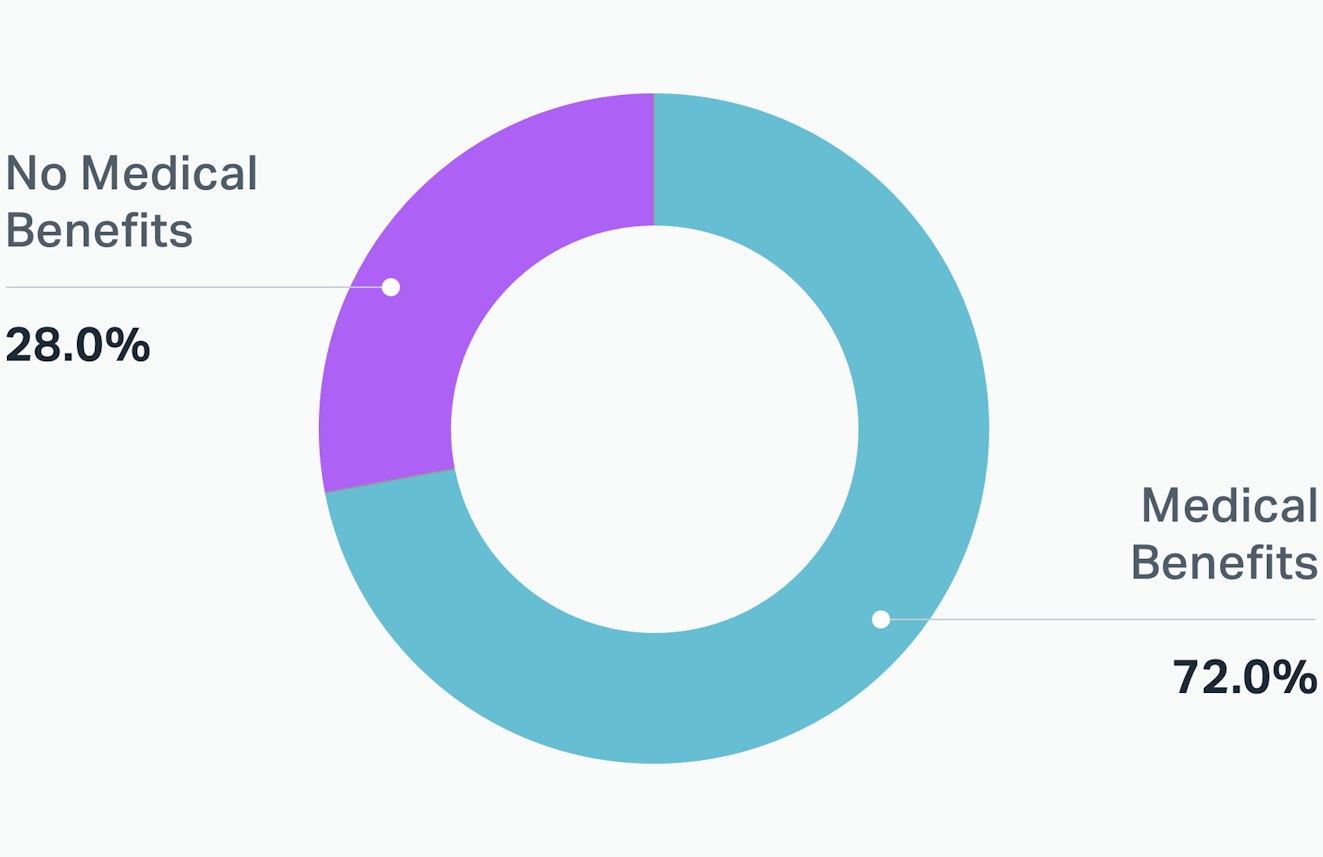
Most survey respondents (72%) receive at least partial medical benefits through work — definitely more of a critical benefit in the U.S. and other countries without government-subsidized health care.
Bonuses
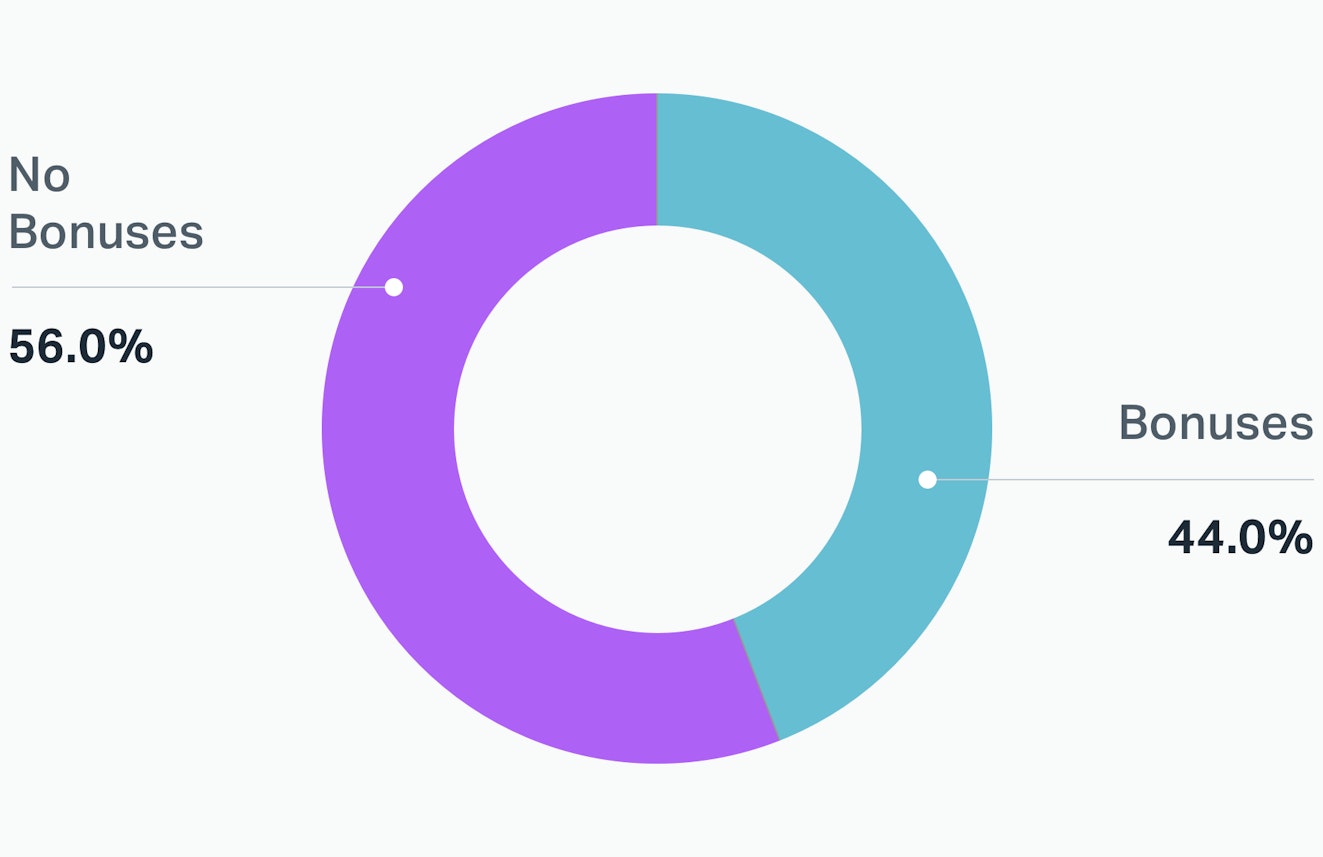
An encouraging 44% of survey respondents reported receiving bonuses outside their regular salaries.
Equity
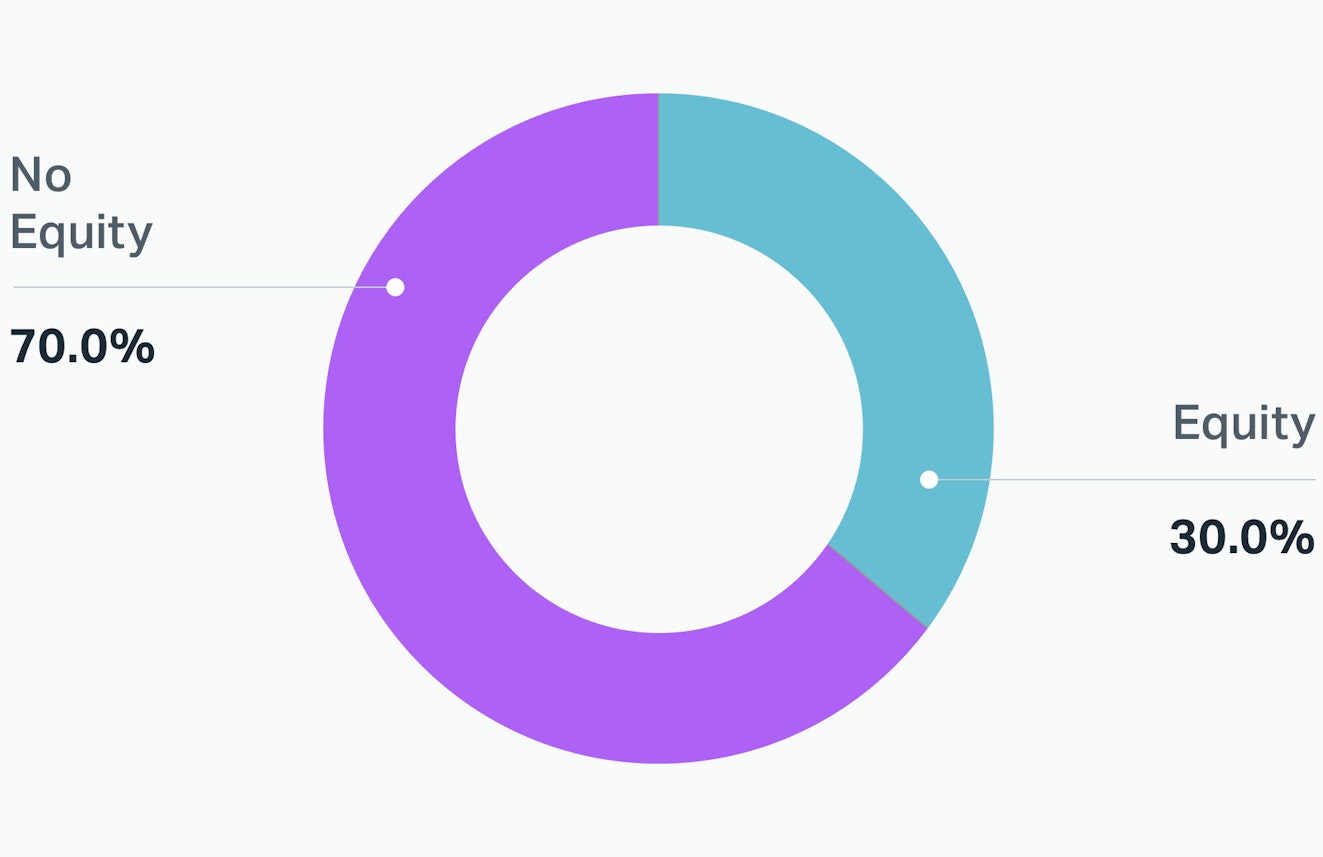
Nearly a third (30%) of survey respondents reported some form of equity in their companies as part of their compensation package.
Professional development
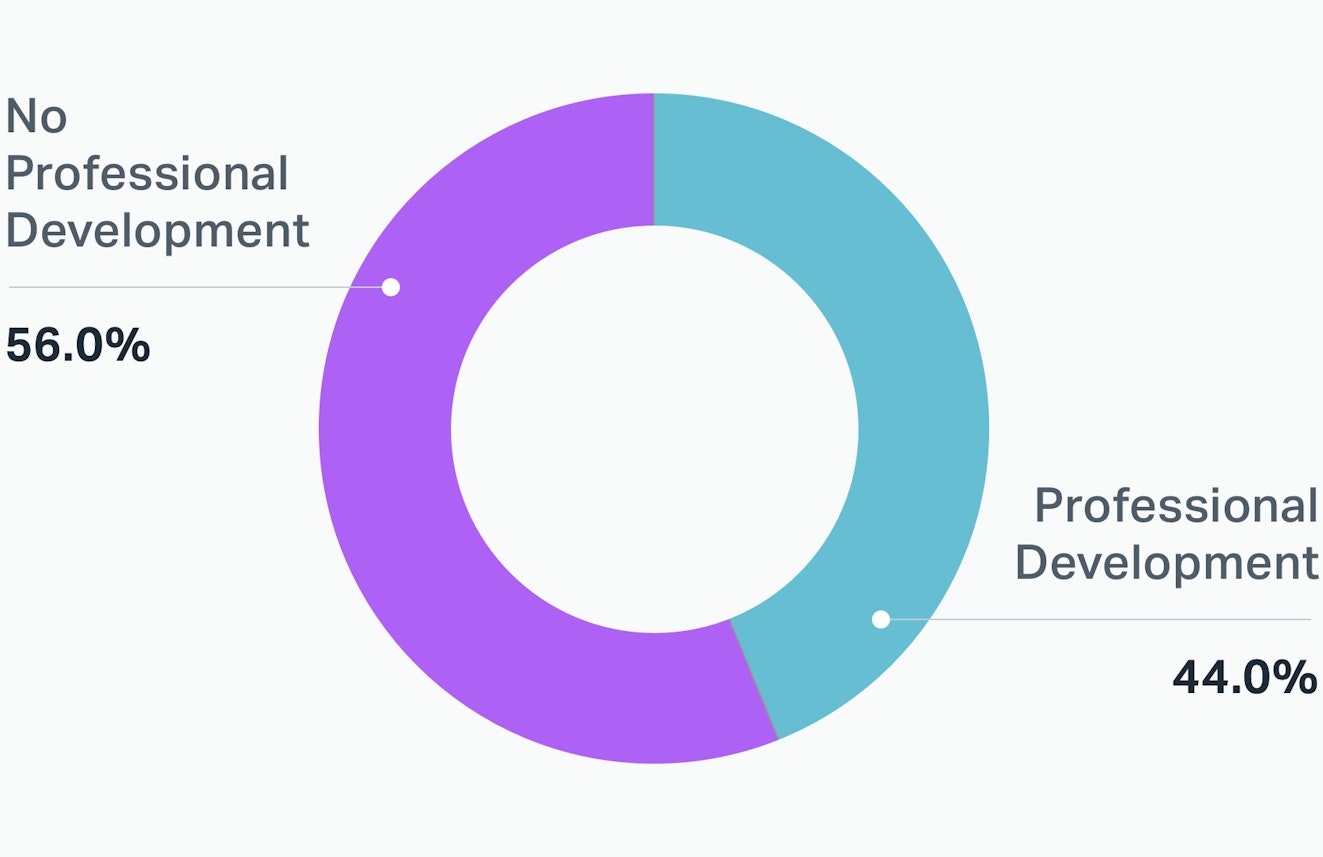
Among survey respondents, 44% said their companies pay for professional development such as conferences, continuing education, seminars, and books.
Parental leave
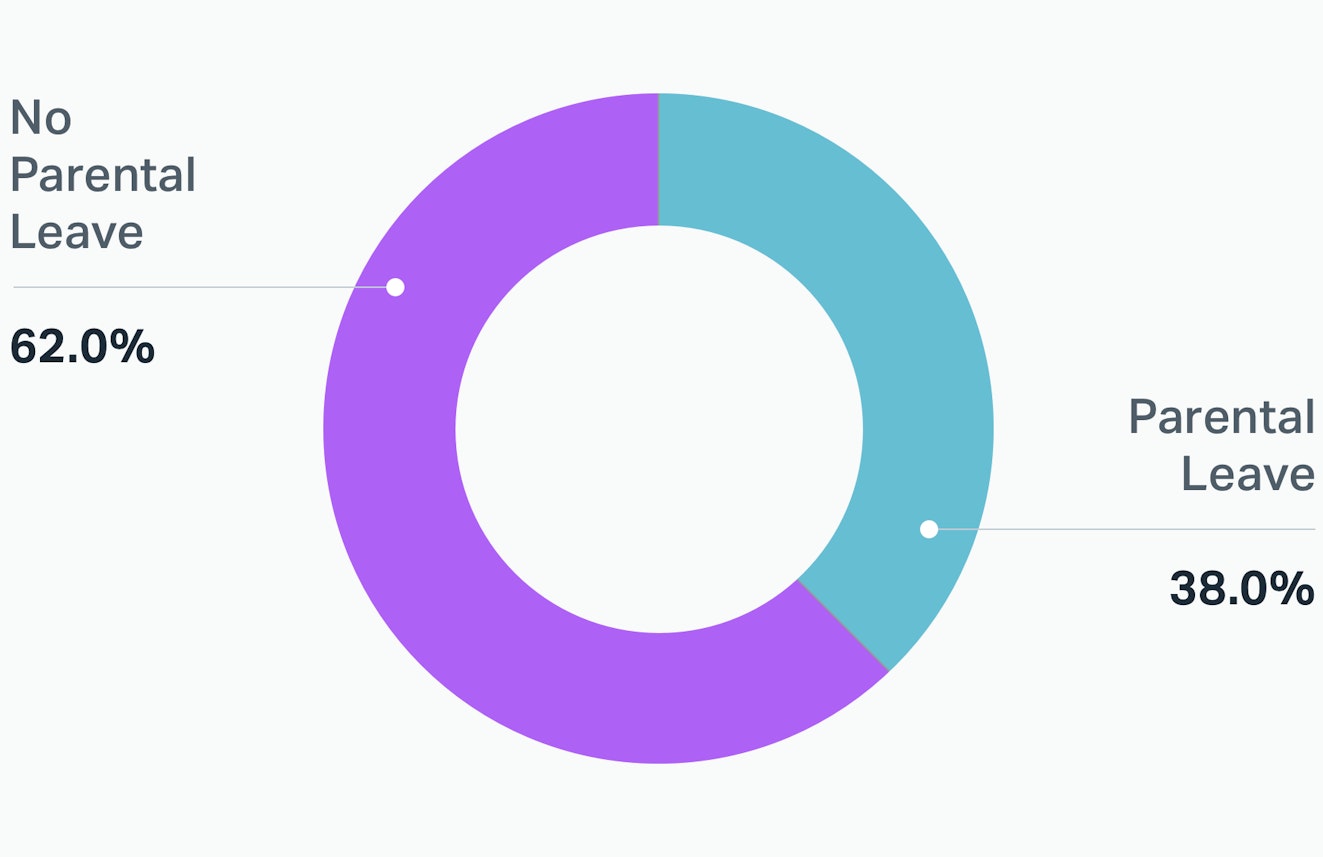
This is another benefit that’s more critical in some countries than in others: 38% of respondents said their companies offer more parental leave than the 12 weeks of unpaid leave required by the U.S. Family and Medical Leave Act, but this is a global survey, and many countries in Europe and elsewhere have more generous parental leave laws than the U.S. does.
Retirement
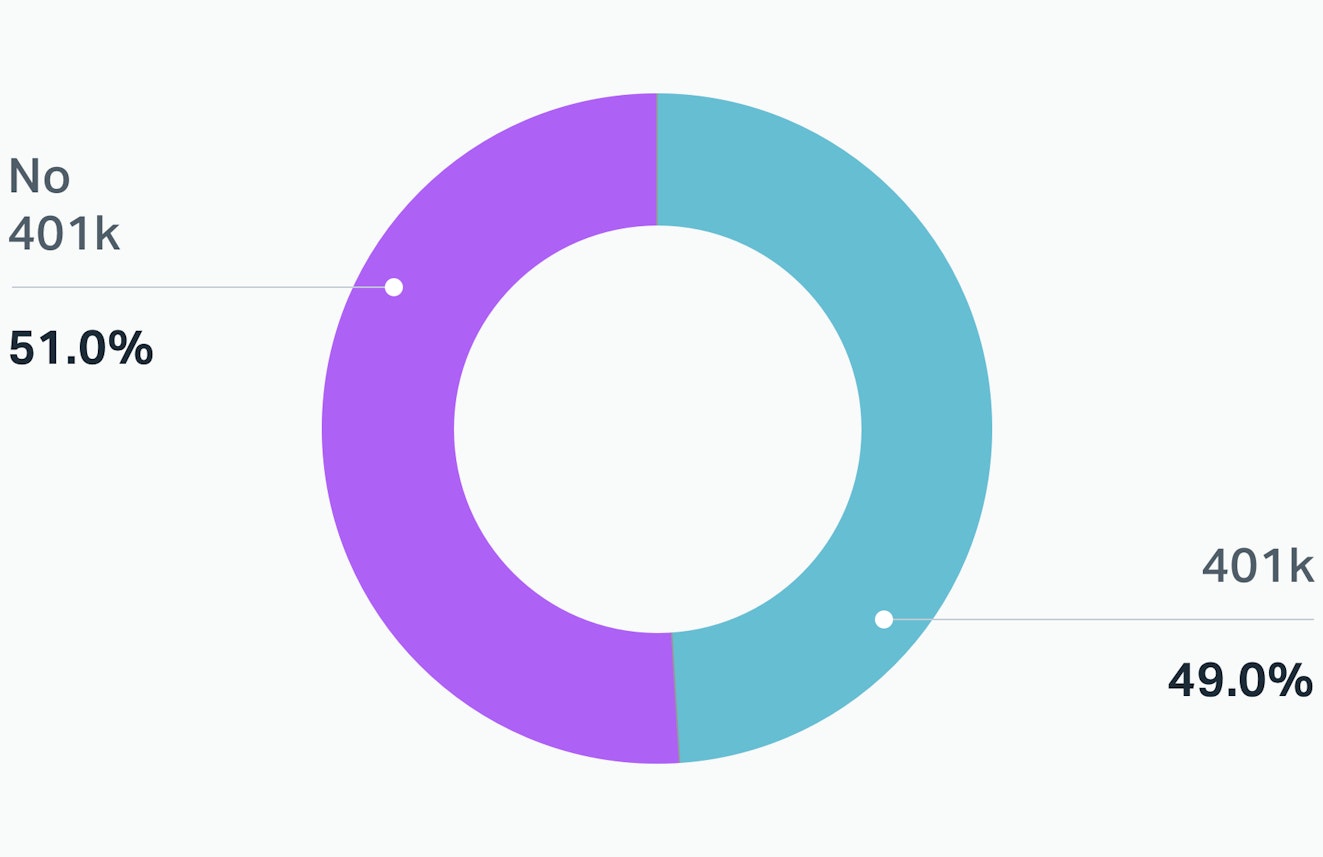
Nearly half (49%) of customer support professionals have a 401k or other retirement plan option through work.
Desired skills
The survey asked “What skills do you want to learn or develop for yourself?” This word cloud represents the most common terms used in the replies:

The survey also asked mangers what skills they’d most like to see their direct reports develop:

2017 support salary study
The number of participants in this study has grown significantly year over year: 551 people took the survey in 2017, up from 203 participants in 2016 and 60 in 2015.
551 participants:
277 Women
257 Men
6 unanswered
5 non-binary
4 Gender unlisted
2 Gender non-conforming
While a sample size of 551 is relatively small, it provides insight into a growing industry and enables business owners, managers, and employees to stay on top of emerging trends.
What are customer support professionals earning in 2017?
The average reported salary for support professionals in 2017 is $57,686. At first glance it appears support salaries have taken a dip compared to prior years’ averages, but that’s not the case. As always, there’s more to the story.
| 2015 | 2016 | 2017 |
|---|---|---|
$65,874 | $68,540 | $57,686 |
Salaries aren’t actually trending down — in fact, most individual salaries either stayed the same or went up. If the people who filled out the 2017 survey had also filled out the 2016 survey, they’d show a $2,935 average salary increase year over year. So what’s up with the lower overall average?
Why does the average support salary appear lower in 2017?
Broader industry participation
With more than double the number of survey participants this year (551 in 2017, versus 203 in 2016), we also saw three times the number of non-director respondents (125 in 2016 versus 480 in 2017), while the number of director-level participants decreased (78 in 2016 versus 71 in 2017).
While it’s tricky to extrapolate from the data, it appears as though the larger participation of support professionals who are earlier in their careers is contributing to a lower overall average.
Greater international participation
In 2016, 16% of responses came from outside the U.S. and Canada; in 2017, 29% of all responses did. The average support salary in the U.S. and Canada was $64,017 in 2017, or $6,331 higher than the international average.
No indication of employment status
It may also be that a higher percentage of part-time workers responded to the survey in 2017 than in past years, potentially artificially lowering average salaries. In future surveys, we’ll include a question about employment status to test this theory.
Why the shift in participants?
In past years, the majority of responses came largely from the Support Driven community, which includes a number of higher-paid professionals (many of whom are in the SaaS industry, where salaries tend to be higher — more on that later in the report). But as we broadened the call for participation this year and received a wider range of responses, we’re seeing a bigger picture of the industry at large.
Do support salaries differ by industry?
In 2017, we added the question “In which industry is your business?” to the survey.
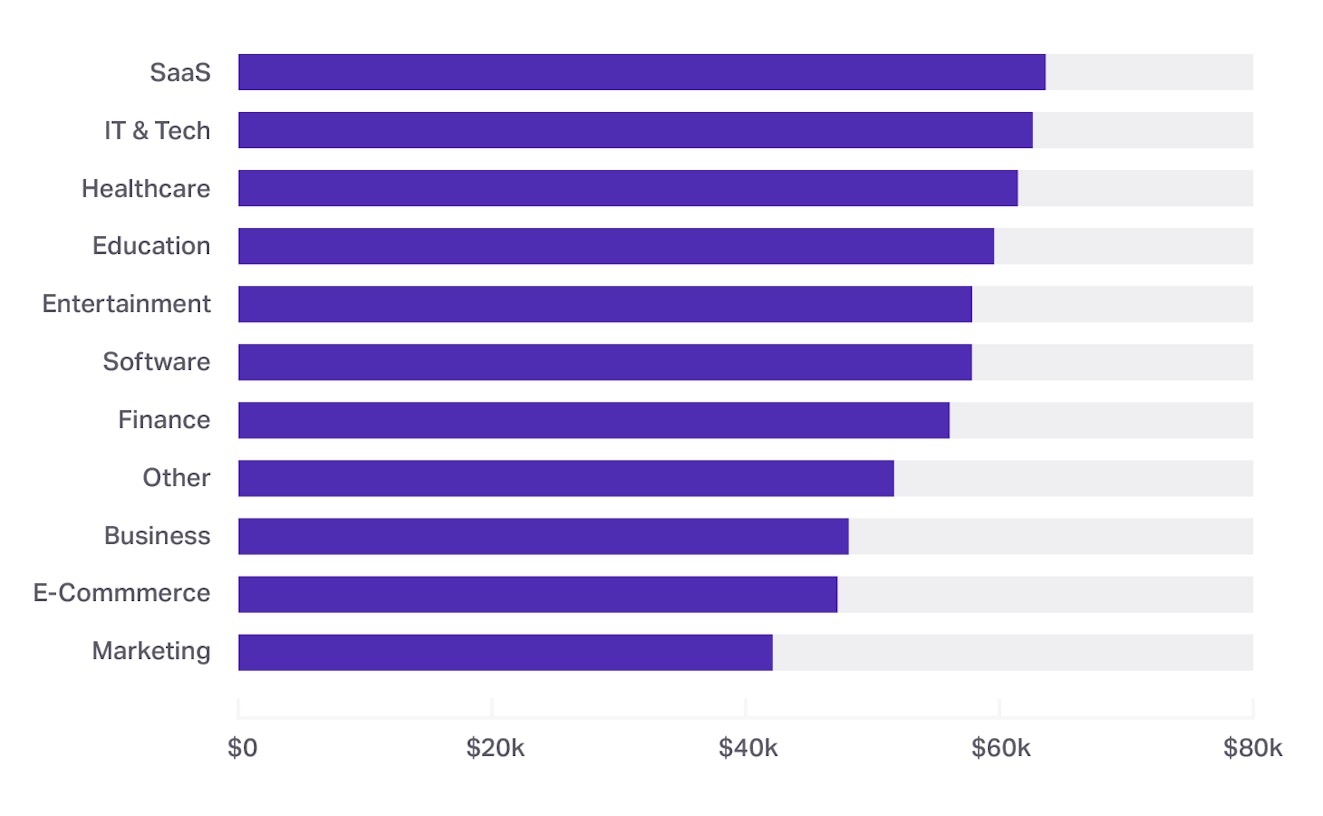
The “Other” category includes people who responded with “Other,” as well as industries with fewer than 10 respondents: Transportation, Internet of Things, Non-profit, Data and Analytics, and Computer Hardware.
The industry that saw the highest wages for customer support professionals in 2017 was Software as a Service, with an average salary of $63,651. Marketing had the lowest average salary of $42,128, although there were only 15 respondents in that industry.
Industry highs
SaaS companies pay the highest wages for customer support in 2017, with an average salary of $63,651.
Is the gender pay gap closing?
In 2017, the average pay for women in customer support is $55,503; men’s average pay is $58,663. This is only a slightly lower discrepancy than last year (and in comparison to other industries in general): Women make 94.6% of what men earn in support in 2017, compared to 94.4% in 2016.
Similar to last year’s report, women earn slightly more than men at entry level but fall behind with more years of experience (5+ years).
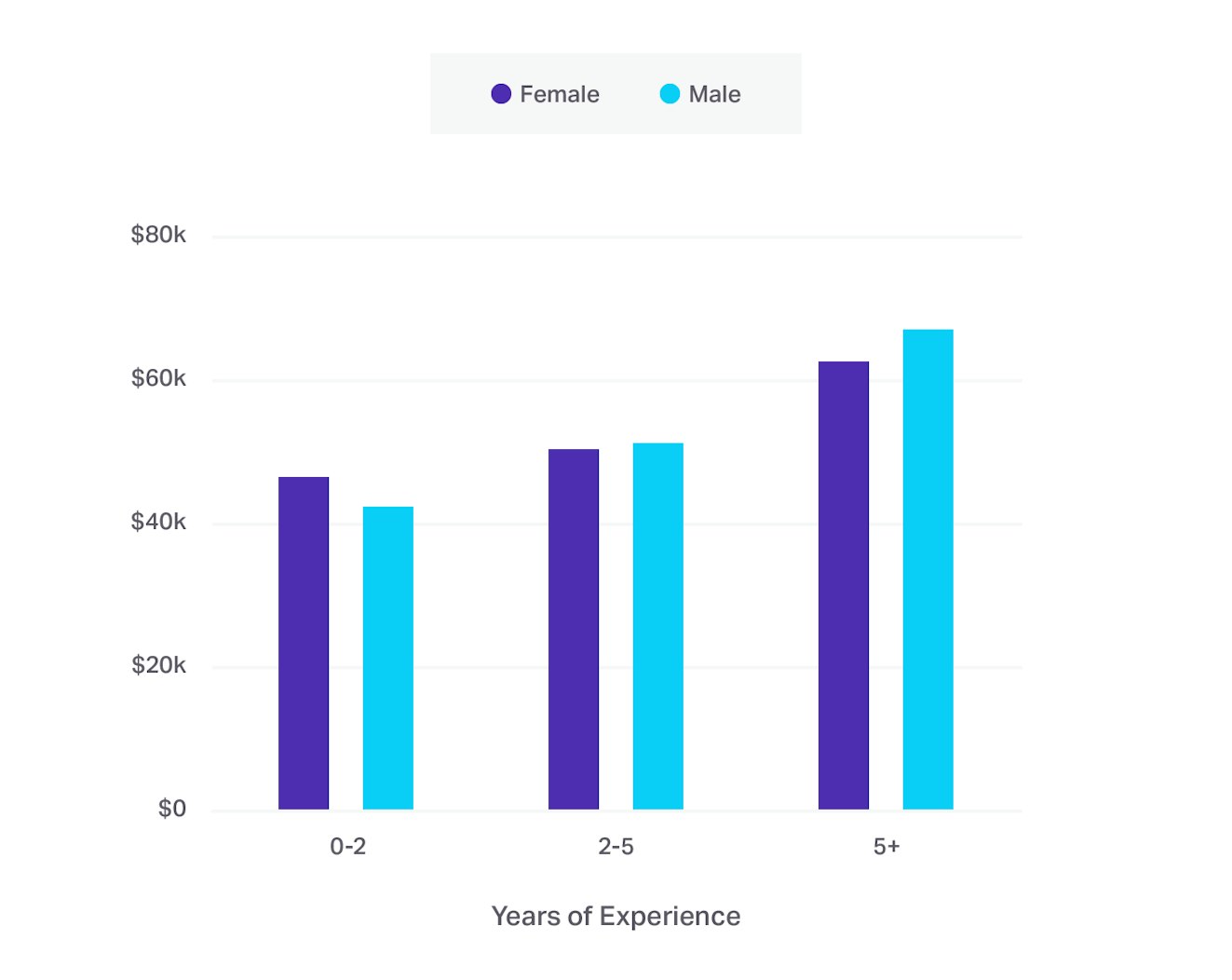
Non-binary, gender-nonconforming, and those who preferred not to answer or whose gender was not listed are not depicted in charts due to small sample size.
What do support pros earn by job title?
We expanded the options in this year’s survey to get a better idea of what people earn by job title. In 2016, we offered the following options: “I help customers,” “I lead a team but I'm not head of support,” and “I'm in charge of the entire support operation.” The updated job title options for 2017 are: Agent/Representative, Lead, Manager, Director, VP or Other.
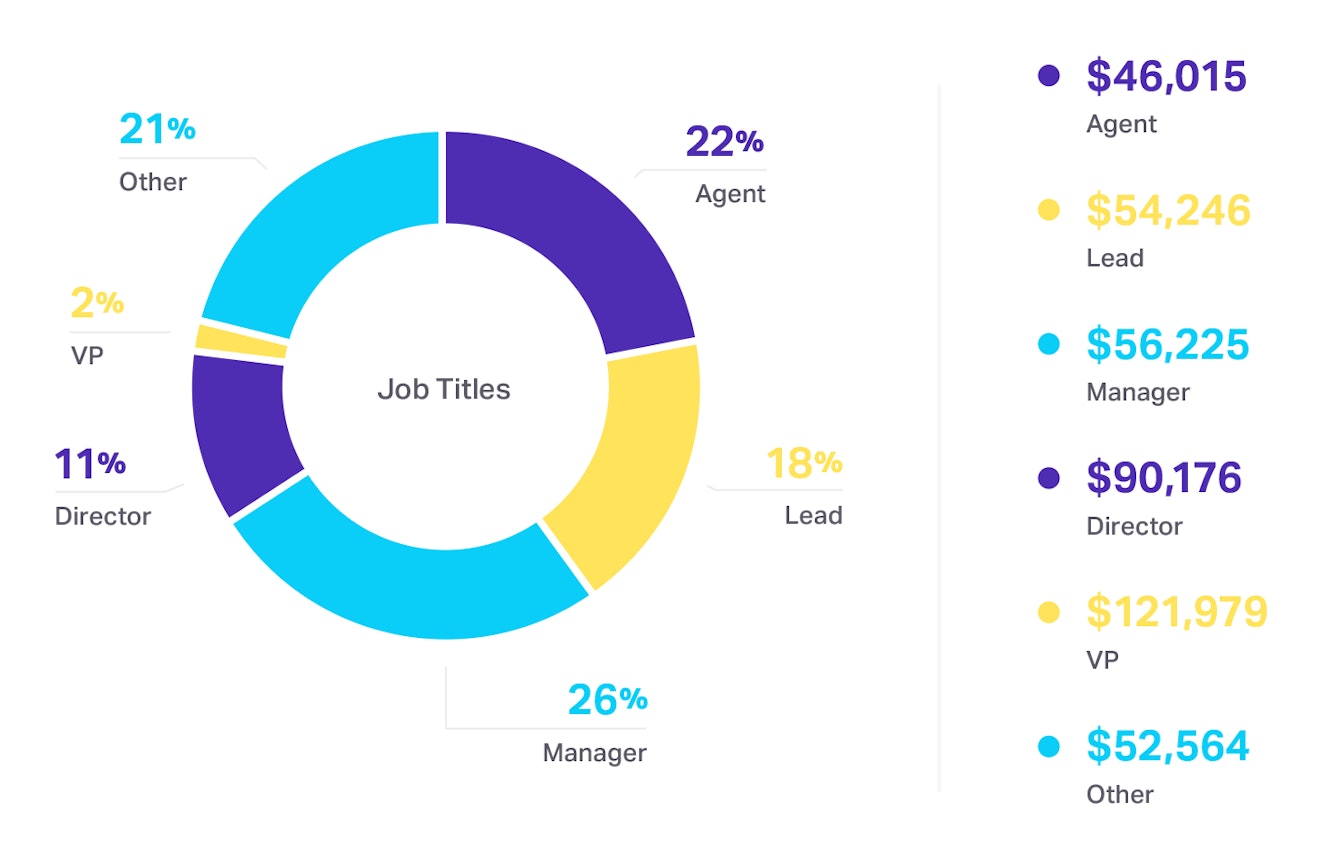
The previous year’s version may have been a better approach, because for this year’s survey, the interpretations for the “Other” category were quite varied (from “Associate” to “Chief Happiness Officer” and everything in between).
Job titles by gender
Similar to the gender breakdown by years of experience, we see more women in agent/representative and manager roles, while more men report working in lead, director, and VP roles. This seems consistent with recent research suggesting that the pay gap widens as women are promoted.
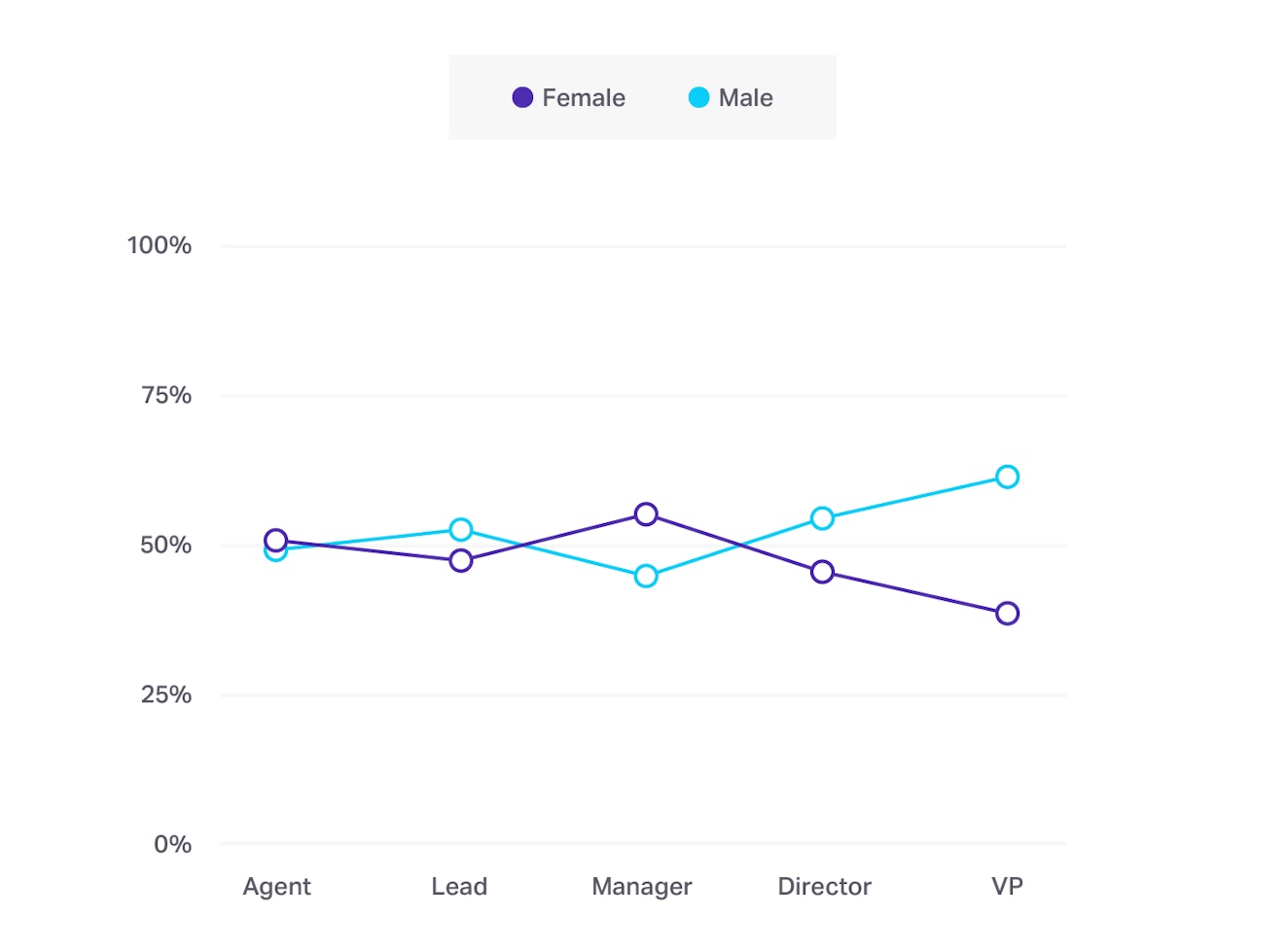
Do technical skills mean higher salaries?
Responses to the question “Are you providing technical support?” told a different story this year than they did in 2016. The majority of the survey respondents in every salary range identified as technical.
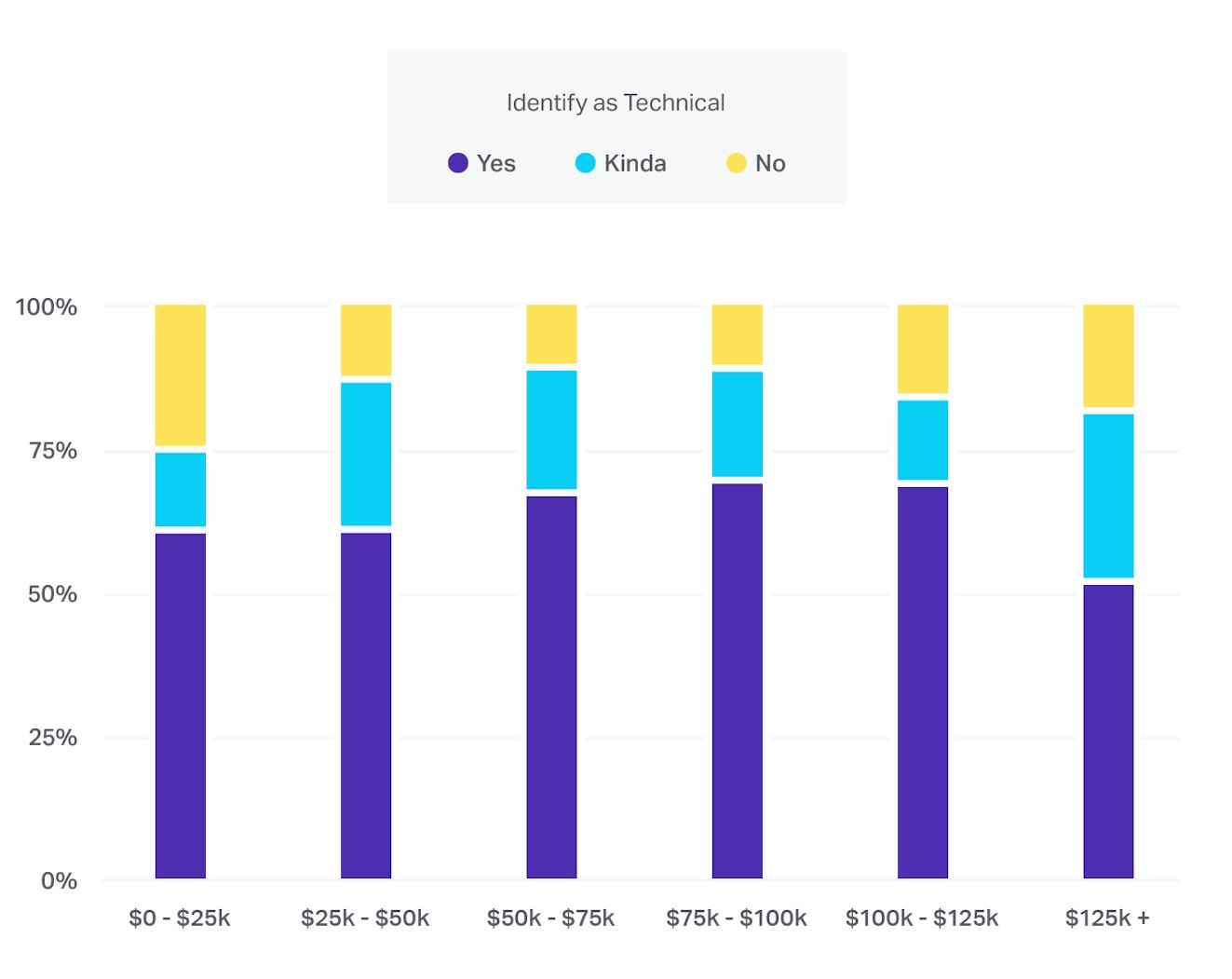
However, there wasn’t as much salary variation between support professionals who assist customers in a technical capacity and those who do not. On average, customer support professionals who provide technical support reported slightly higher salaries on average in 2017 than those who do not:

Salary depending on technical ability, however, may again be impacted by differences in title. For example, technical professionals make more in all roles except as VPs. Which makes sense: Professionals who are higher up the chain may be more involved in areas such as project management, personnel development and so on, and have less need for technical abilities.
Reported technical skills by gender
Similar to 2016, more women reported being “kinda” technical or not at all, while more men answered “yes” to providing technical support.
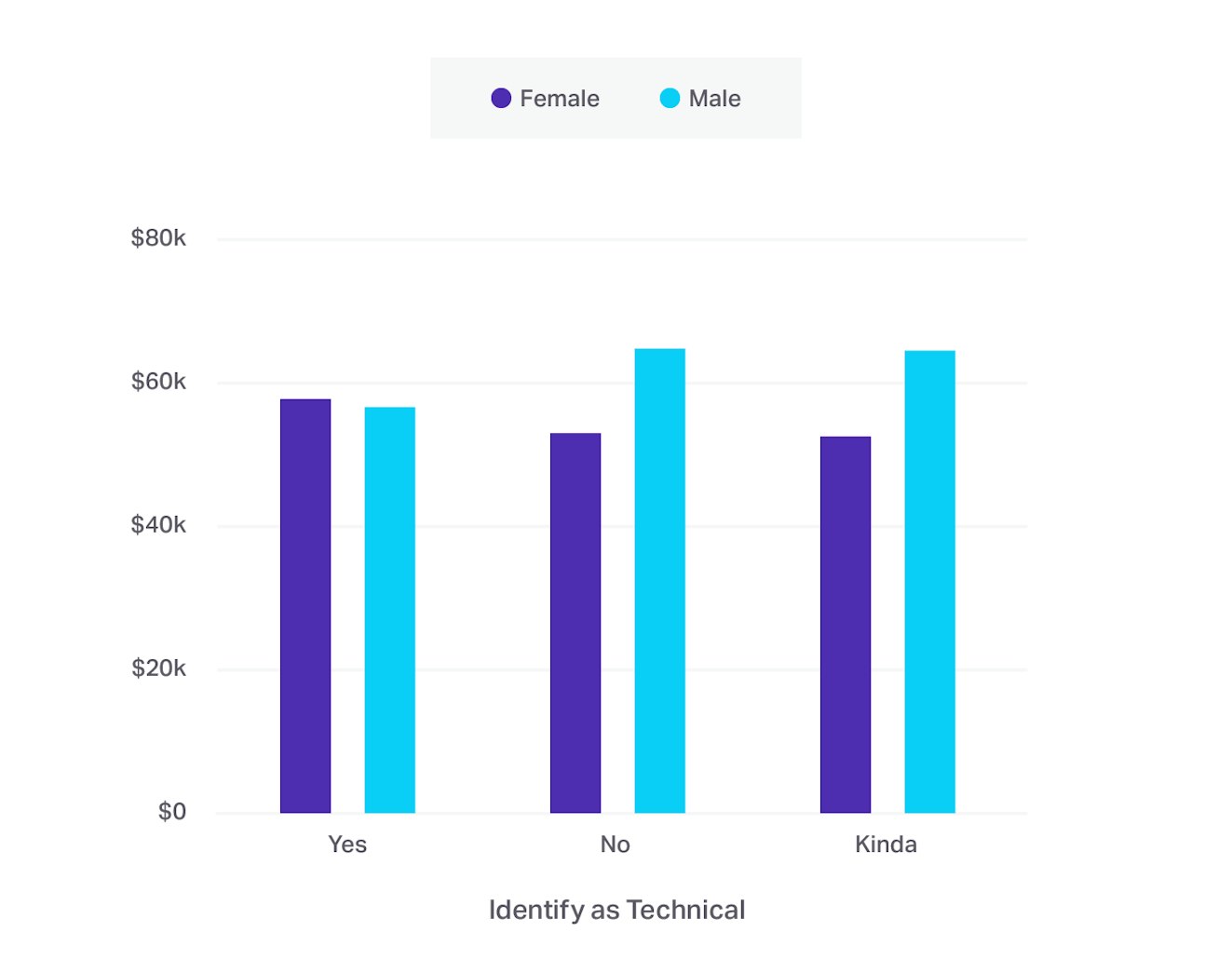
The ambiguity of self-reporting is a little tricky — what does “technical” mean? How technical is “kinda technical”? Research shows that women tend to downplay their technical abilities, while men may exaggerate theirs. It’s true you’ll find more men than women in technical fields, but between a man and a woman doing the same work, would a man identify as technical while a woman identifies as kinda technical?

We asked those identifying as “kinda technical” to explain in their own words, and we saw interpretations ranging from “setting up teams with the printer” to “some reporting and data analysis” to “knowledge of HTML, CSS and JS is required since we look into the page source code.” There was too much variation to draw any meaningful conclusions from the data this year, but the information it is useful in helping us frame the question better in future surveys and perhaps define what “technical” means.
Are remote jobs still on the rise?
Remote work continues to be on the rise in customer support, and it pays. The average salary for full-time remote workers is $62,604, compared to $53,344 for people who do not work remotely at all.
This occurs across other industries in the U.S. and around the world. Gallup’s 2017 workforce survey, for example, reports that 31% of Americans work remotely 80-100% of the time (four-five days per week), up six percentage points from 2012-2016. And that’s good news for customer support salaries: Support professionals who work remotely have the highest average salaries.
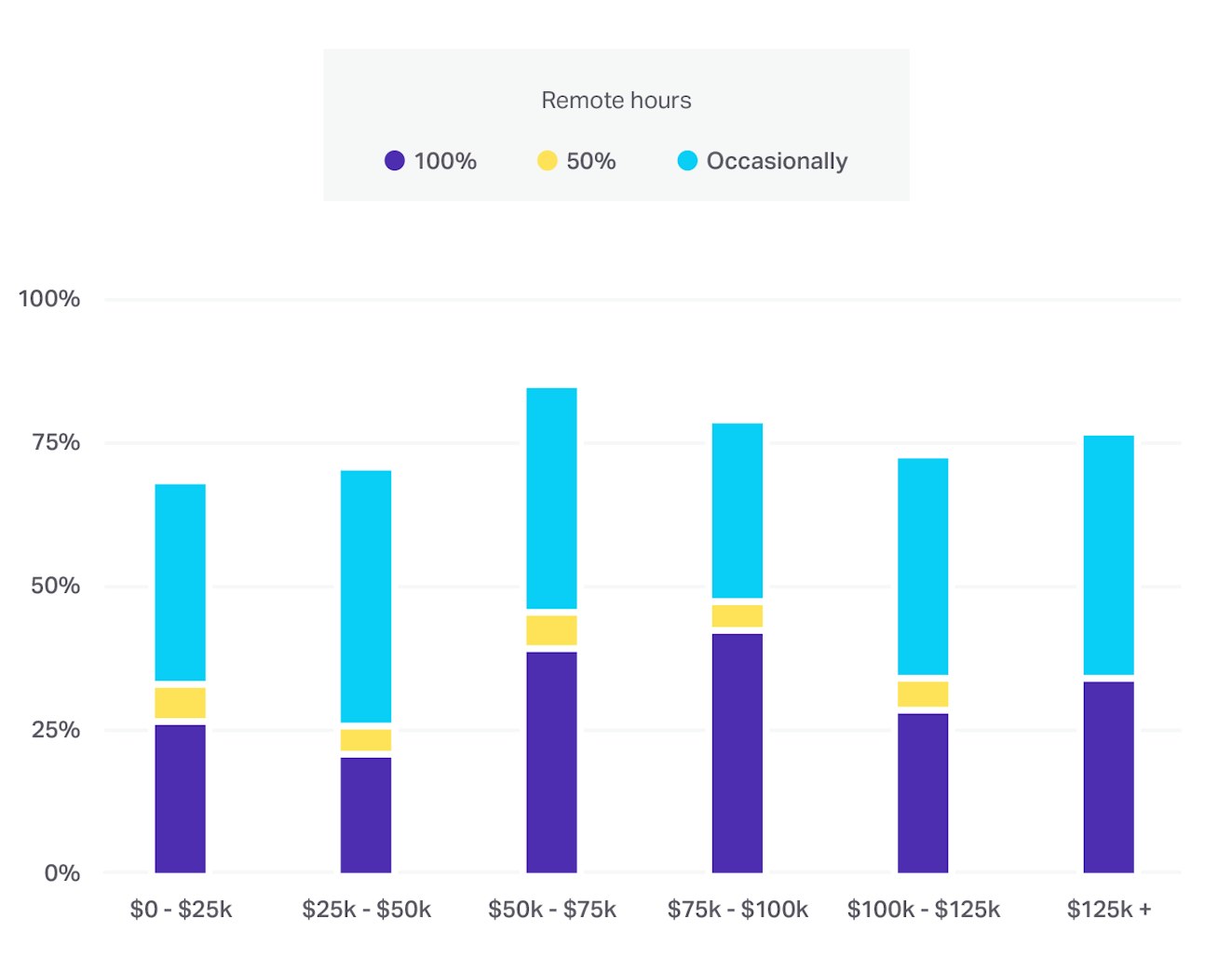
However, the breakdown by salary range shows that beginning at the $100,000 mark, salaries for co-located and remote support workers begins to even out. At the highest bracket, co-located support pros earn more — a trend that has not changed much since 2016.
| 2015 | 2016 | 2017 |
|---|---|---|
60 Respondents | 203 Respondents | 551 Respondents |
20 (33.3%) Remote Workers | 81 (40%) Remote Workers | 164 (30%) Remote Workers |
40 (66.6%) Co-Located | 122 (60%) Co-Located | 387 (70%) Co-Located |
SaaS companies are still the most “remote”
By far, more customer support professionals are working remotely for SaaS companies than other industries, indicating that they still account for the rise in customer support salaries.
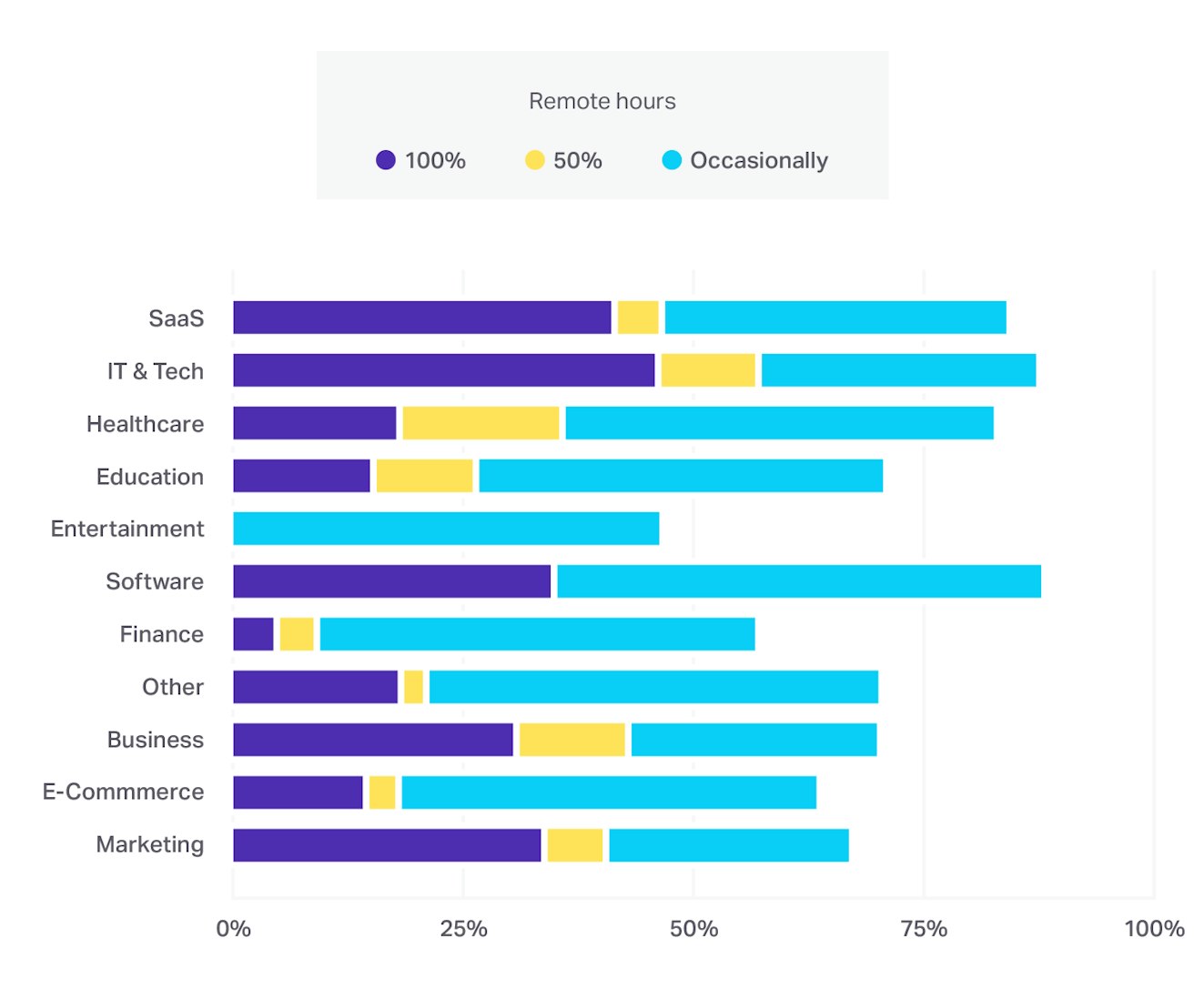
Remote workers report higher job satisfaction
People who work remotely 100% of the time were likelier to report that they were not looking for a new job: 66% of remote workers are happy where they are, compared to 43% of respondents who go into an office every day. That’s in line with studies that show employees who are permitted to work remotely show higher job satisfaction (as well as higher performance).
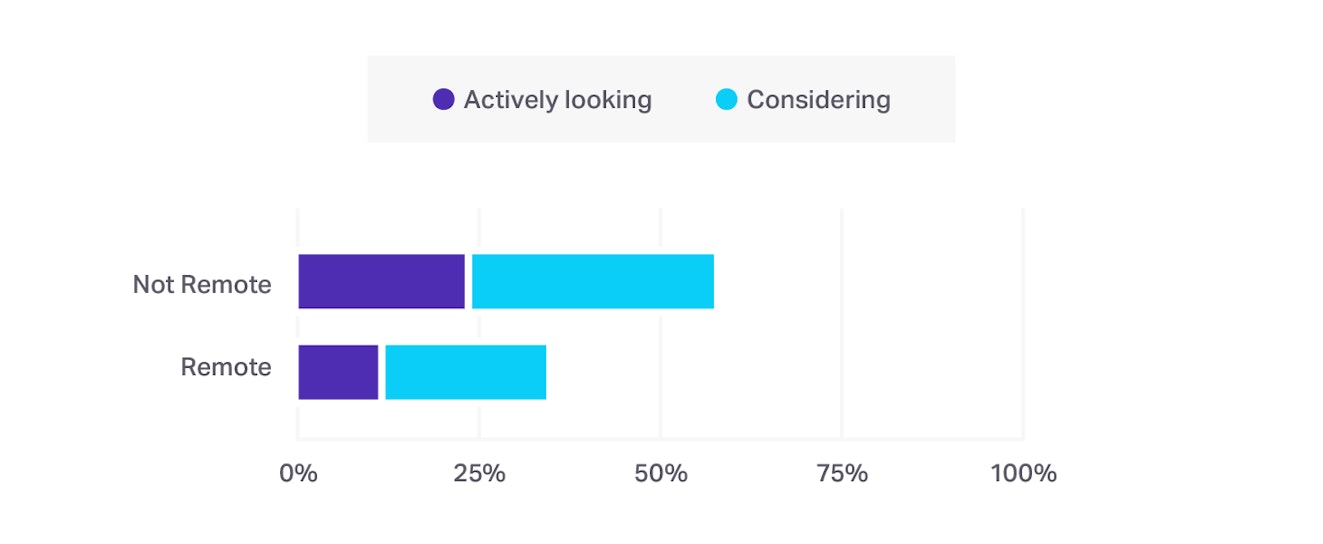
While it’s not for everyone, the increasing popularity of remote work and decent support salaries are great news for any support professionals who enjoy the freedom of working from wherever they choose. If you’re looking for remote work opportunities, here are some places to start:
Remote work resources
Support Driven: Exclusive to jobs in customer support, both remote and co-located.
We Work Remotely: Comprehensive remote-jobs-only site, created by the folks at Basecamp/writers of Remote. Includes a section dedicated to customer support.
Remote.co: Has a job board section for customer service-related work. Job seekers can sign up to have new job posts emailed to them.
Remote OK: Lists customer support work among its non-technical job listings and lets searchers filter for the highest-paying jobs.
Remotive: A remote jobs community, hosts a remote job site with a section dedicated to support.
Working Nomads: Curates a remote jobs list with a section dedicated to customer success.
Does working remotely increase your spending power?
Salary ranges for people living in low, medium, and high cost of living areas is fairly consistent with 2016, and the takeaway for support pros should still be the same: Living in low- to mid-range cost of living areas and working for companies based in high-cost, high-salary areas will maximize your spending power.
Remote work sweet spot
Customer support pros who work remotely and live in lower-cost-of-living areas get the most from their salaries.
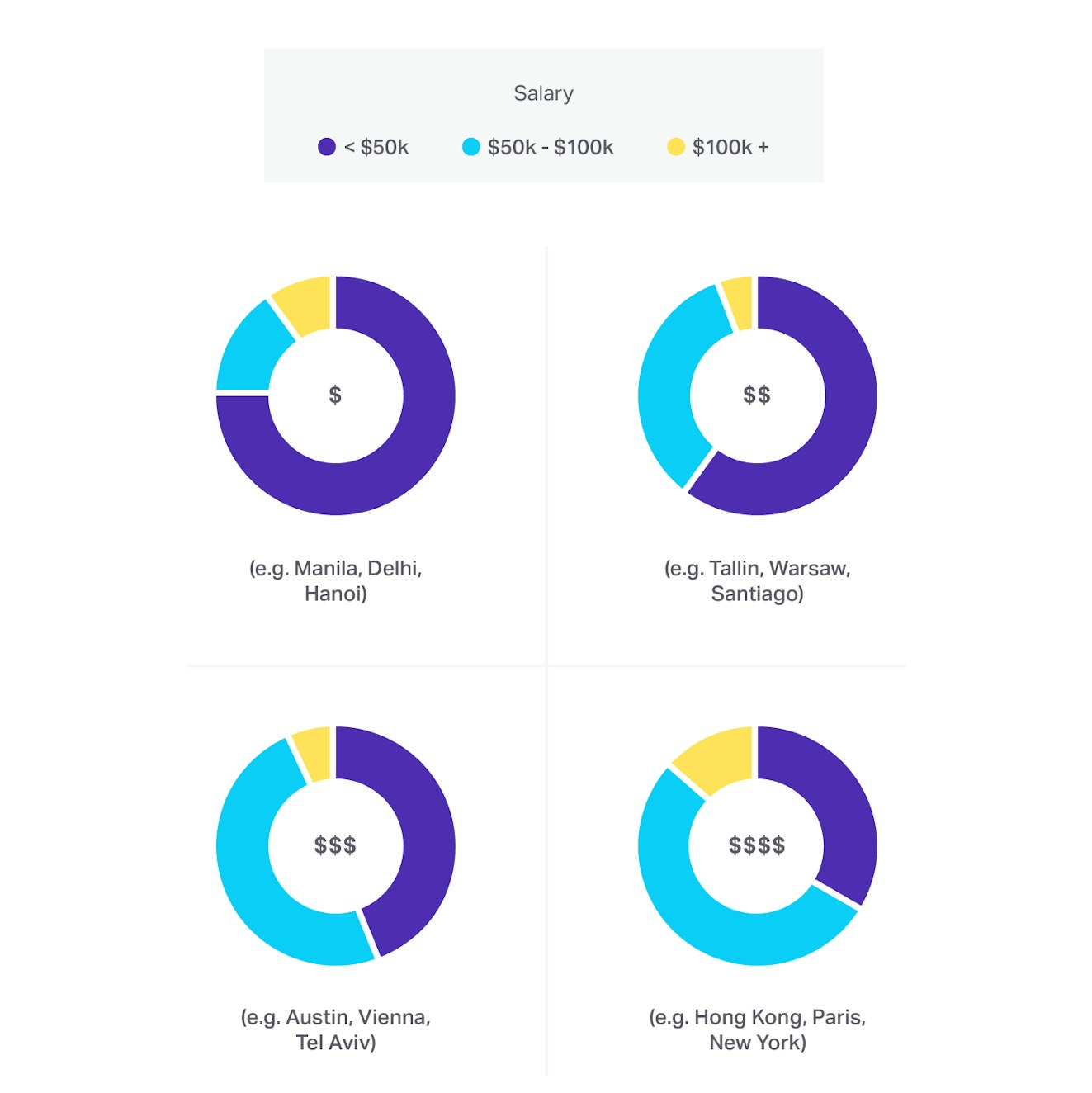
2016 support salary study
We’ve conducted an anonymous survey that asks customer support professionals around the world what they earn in regard to their gender, local cost of living, company size, seniority, skills, and experience.
203 people responded to the survey — more than three times the participation from the previous year’s survey:
109 were men
91 were women
3 declined to identify
The average salary for a customer support professional in 2016 is $68,540, up $2,666 (4%) from last year’s average of $65,874. Women’s median pay is $65,000; men’s median pay is $68,800. This discouraging link between salary and gender is present throughout the results, regardless of other factors such as company size or location.
Maximizing your spending power
Based on this year’s survey results, the best ways to maximize your spending power as a support professional are:
Work remotely in an inexpensive city.
Have some technical skills.
Stick with it — it pays more over time.
We should note that a sample size of 203 is problematically small and that we refrained from making too many comparisons between this year and last year’s data due to 2015’s even more problematic sample size of 60. This resource, therefore, should be referenced in conjunction with other sources — in other words, don’t base your support team’s salaries or compare your own salary apples-to-apples using this information alone!
It’s also worth noting that the majority of responses came from a community that cares deeply about customer support. These are professionals who excel at what they do and are invested in support as a career — many of them are management-level or have been working in support for years. Of course, other factors such as benefits come into play when considering compensation, and this study does not address all of those. This resource is only intended for context, in other words — not as a definitive guide for how much employees at widely differing organizations should be paid. More and more companies are embracing the science that shows customer experience is a major driver of future revenue, and support professionals have ever-greater choices when it comes to employers who will value their talents and compensate accordingly.
If you’re curious how salaries compare among support professionals working for companies that view high-quality support as essential to their success, read on!
Men make more
The results of this year’s survey unfortunately corroborate what women around the world and across other industries experience. While it doesn’t exactly qualify as good news, we can at least say that the gender wage gap in support is not quite as wide as it is across other industries.
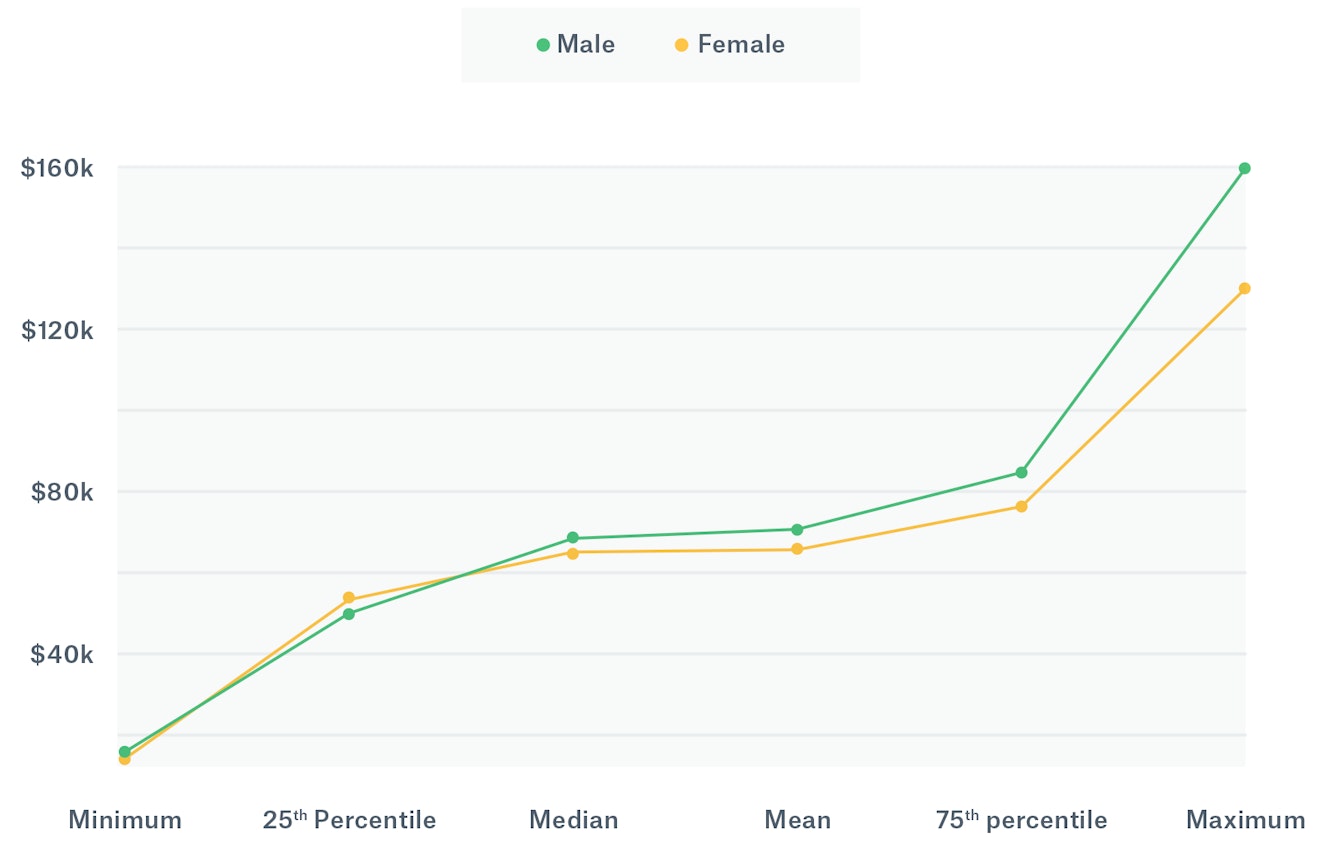
The median salary is somewhat encouraging
Women make 94.4% of what men make in support.
Among lower-paid support professionals (the 25th percentile), women earn more than men.
Looking at the mean, 75th percentile, and max salaries, men tend to earn significantly more. At the 75th percentile, women make 90% of what men do, and at the max, it’s down to 81.25% of men’s salaries. The mean is prone to being skewed by “outliers” — in this case, men’s salaries at the top are pulling that mean up.
The main differences between genders when it comes to salary occur at the higher levels.
There’s still work to be done equalizing pay in support as in other professions, and we can and absolutely should do better.
Equalize pay in the real world
Acknowledging that gender and race wage gaps still exist.
Offering benefits packages that support all parents with paid leave.
Encouraging women to negotiate salaries while working to end the structural sexism inherent in the perception of women’s negotiation efforts.
Sharing salary and diversity data publicly (Buffer handles this extraordinarily well).
Removing bias from hiring processes, and using tools like Textio to address unconscious bias in job postings.
These practical applications are in everyone’s best interest since we know diverse teams perform better.
Experience pays
The chart below is fairly obvious — the longer you work in support the more you're likely to make!
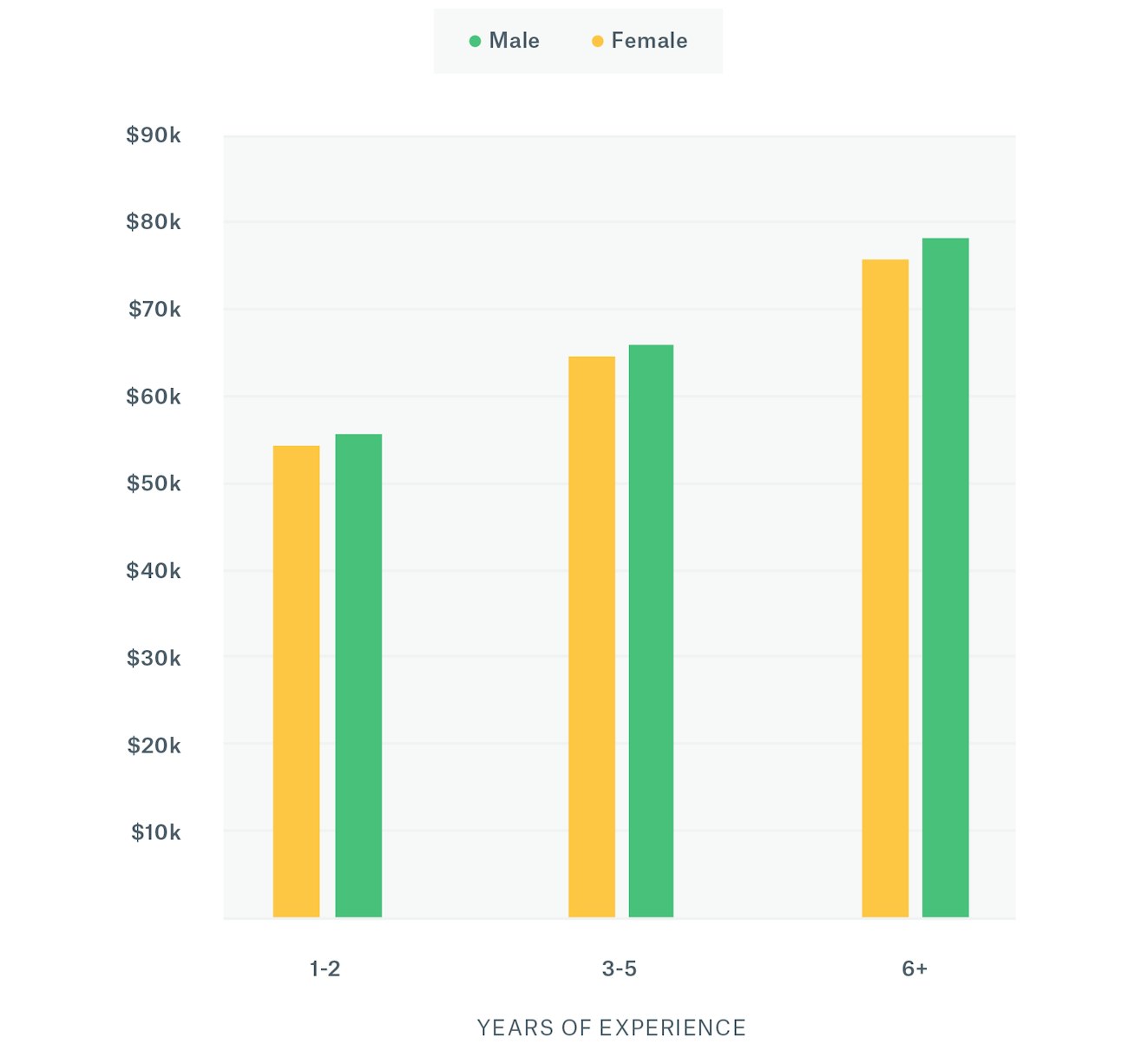
Another non-surprise: The top earners are mostly men. While more men than women responded to this year’s survey, we do see a number of entry-level women coming into support, but the number of women decrease as years of experience increase. Likewise, women’s salaries outperform men’s at the entry level but fall behind with more years of experience.
We do know, however, that women are more widely represented in support than in other fields related to SaaS and ecommerce, such as engineering. Help Scout’s support team, for example, is 80% female, but as of this writing, women make up only 27% of everyone at the company. These statistics seems fairly consistent, at least anecdotally, across the field.
Technical skills pay
This shows pay by gender and self-identified technical abilities. Those who self-identify as “technical” are overwhelmingly male.
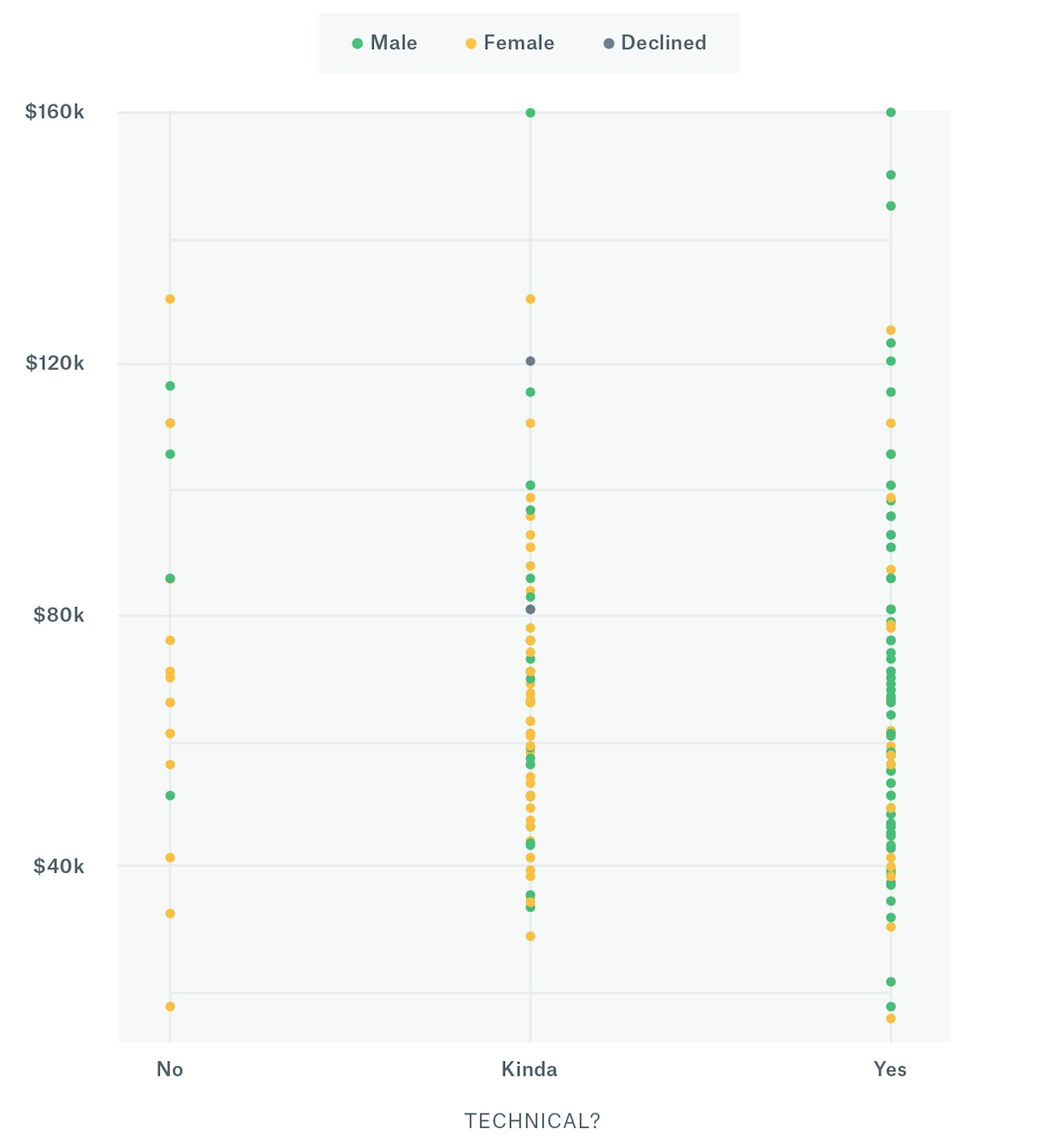
The ambiguity of the self-reporting is a little tricky — what does “technical” mean? How technical is “kinda” technical? At least in the U.S., few truly “technical” workers (engineers, data scientists, etc.) make less than $80,000 per year. Does this data show that these responses overwhelmingly came from outside the U.S. or that respondents interpreted “technical” as “I do some coding in my support job”?
Our hunch is the latter, accompanied by the research that shows women tend to downplay their technical abilities, while men exaggerate theirs. It’s true you’ll find more men than women in technical fields, but between a man and a woman doing the same work, would a man identify as technical while a woman identifies as kinda technical?
Technical skills pay, even for non-engineers doing support
In addition to helping you earn more, it also means you might not have to wait on someone else to get your work done.
Remote work on the rise
The below graph suggests the highest- and lowest-paid workers are in-office.

Remote workers dominate the middle salary range, but low-paid workers and high-paid workers (at well-funded startups in high-cost-of-living areas, maybe?) are expected to show up at the office.
| 2015 | 2016 |
|---|---|
60 Respondents | 203 Respondents |
20 (33.3%) Remote Workers | 81 (40%) Remote Workers |
40 (66.6%) Co-Located | 122 (60%) Co-Located |
Remote work appears to be on the rise in support as it is across other industries in the U.S. and around the world. While remote work isn’t for everyone, its increasing popularity and decent support salaries are great news for any support professionals who enjoy the freedom of working from wherever they choose.
Remote salary distribution
Salaries appear to be more varied at co-located companies, but on average, people who work at the office tend to earn a little more. The median salary for co-located workers is $65,220 and $65,000 for remote workers.
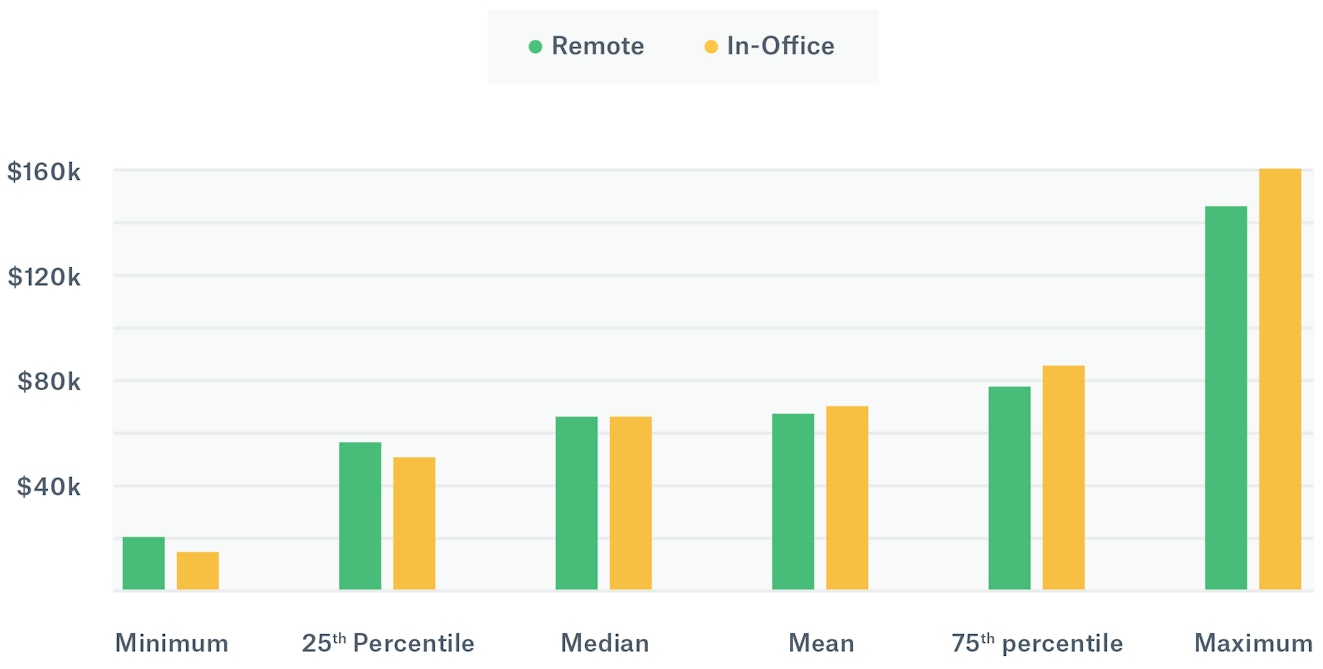
While it's true co-located workers earn slightly higher salaries, there are a larger number of lower-paid workers at co-located companies than there are at remote companies. At the 25th percentile remote workers earn more: $55,000 per year, compared to $50,000 per year for co-located workers. At the 75th percentile it reverses: Co-located workers earn $85,000 while remote workers earn $77,000.
Cost of living
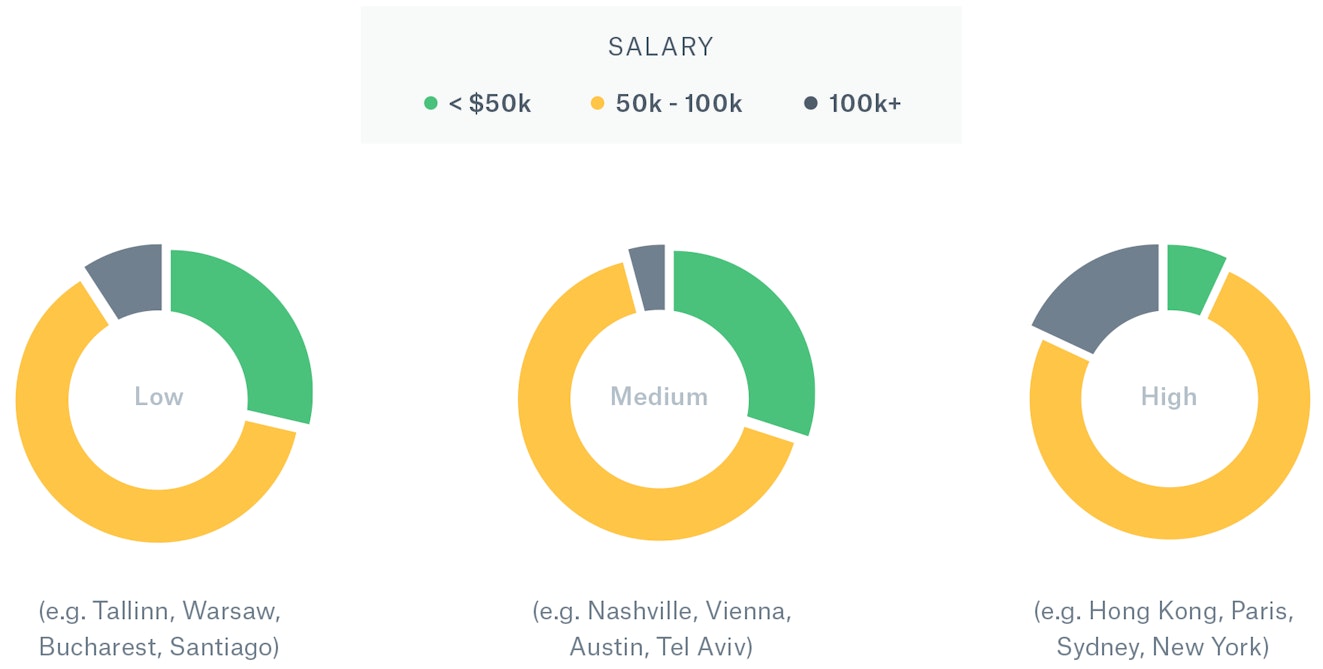
When compared to cost of living, the study appears to show that remote employees who live in mid-range cost of living areas and work for companies based in high-cost, high-salary areas end up making quite a bit more.
Thank you!
Thank you to the members of the Support Driven community who took the time to participate in the survey, and especially to Sahra Santosha, Brian Kerr, Simon Ouderkirk, and Romain Lapeyre who contributed to a thorough analysis of the results.



